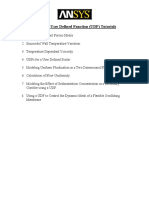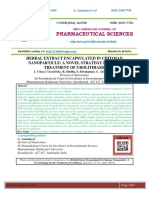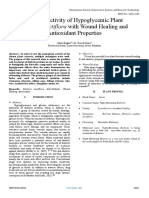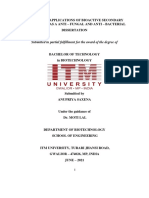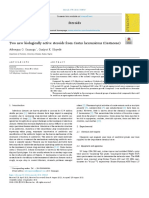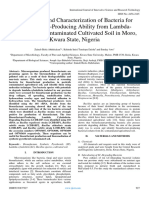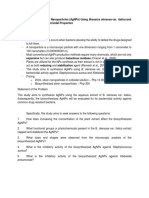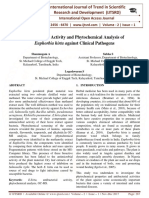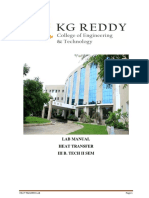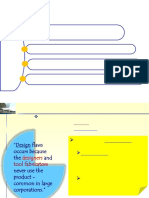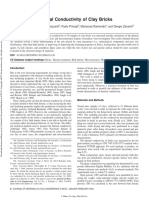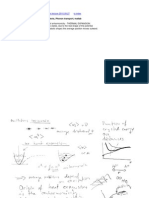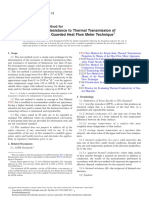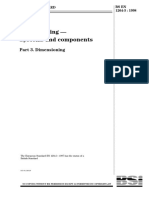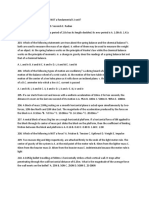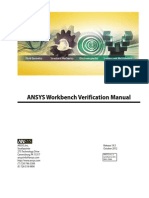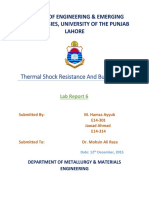Professional Documents
Culture Documents
Development of Nano-Niosomal Formulation of Alkaloids From Tylophora Indica For Improving Bioavailabilitythrough Oral Delivery
Original Title
Copyright
Available Formats
Share this document
Did you find this document useful?
Is this content inappropriate?
Report this DocumentCopyright:
Available Formats
Development of Nano-Niosomal Formulation of Alkaloids From Tylophora Indica For Improving Bioavailabilitythrough Oral Delivery
Copyright:
Available Formats
Volume 7, Issue 5, May – 2022 International Journal of Innovative Science and Research Technology
ISSN No:-2456-2165
Development of Nano-Niosomal Formulation
of Alkaloids from Tylophora Indica for
Improving Bioavailability through Oral
Delivery
SANTHASEELAN. C., GOKULRAJ.B., ARJUN K.
IJISRT22MAY1874 www.ijisrt.com 1169
Volume 7, Issue 5, May – 2022 International Journal of Innovative Science and Research Technology
ISSN No:-2456-2165
LIST OF TABLES
Table 1. Classification of Catharanthus roseus
Table 2. Standard (Vinblastin sulfate)
Table 3. Test sample
LIST OF FIGURES
Fig. 1. Tylophora indica leaves
Fig. 1.1. Acid-base extraction
Fig. 2. Purification of Tylophora indica alkaloids using column chromatography
Fig. 3.1. Thin layer chromatographic screening for
Tylophora indica alkaloids
Fig. 3.2. HPTLC – Densitometric scanning analysis of samples 5vinblastine sulphate
(standard) and Tylophora indica alkaloids
Fig. 4. SEM image of Tylophora indica alkaloids niosomal
formulation59
Fig. 5.1. Domestic goat intestinal skin
Fig. 5.2. Donor & receptor cell of Franz diffusion apparatus
Fig. 5.3 UV spectrum of ex vivo release of total alkaloids
and niosomal formulations
Fig. 5.4. Steady release of Tylophora indica alkaloids through
niosomes in ex vivo experiments
LIST OF ABBREVIATIONS
nm - Nano metre
mm - Milli metre
µg - Micro gram
IJISRT22MAY1874 www.ijisrt.com 1170
Volume 7, Issue 5, May – 2022 International Journal of Innovative Science and Research Technology
ISSN No:-2456-2165
Table of Contents Page No.
Acknowledgements
Declaration
Bona-fide Certificate
Abstract
List of Tables
List of Figures
List of Abbreviations
Chapter – I
Introduction
Important pharmaceuticals from plants
Classification of Tylophora indica rosea
Alkaloids of Tylophora indica rosea
Medicinal applications of Tylophora indica rosea
Problems associated with plant therapeuticals
Pharmaceutical nanotechnology
Nanovesicles
History of Nanovesicles
History of Nanovesicles
Factors affecting the nanovesicles
Self-assembly mechanism in nanovesicle synthesis
Process of self-assembly
Theory of lipid assembly
Mechanism of assembly
Features of self-assembly
Principles of characterisation of nanovesicles
The Size
Shape
Surface Charge
Entrapment Efficacy
Drug Release
Stability
Storage
Preparation of nanovesicles
Ether injection method
Thin film hydration technique
Sonication method
Microfluidisation method
Multiple membrane extrusion method
Reverse phase evaporation technique
Nanovesicle in Pharmacology
Advantages of nanovesicles
Pharmacological applications of nanovesicles
Transdermal delivery through nanovesicles
IJISRT22MAY1874 www.ijisrt.com 1171
Volume 7, Issue 5, May – 2022 International Journal of Innovative Science and Research Technology
ISSN No:-2456-2165
Intravenous delivery
Ocular drug delivery
Pulmonary drug delivery
Oral Drug Delivery
Drug delivery for cancer therapy
Niosomes
Preparation of niosomes
Applications of niosomes
Niosome as a drug carrier
Current research focus
Literature survey
Improvements in niosomes over years
Scope of the present work
Objectives of the work
Chapter – II Methodology
Experimental Methods
Plant specimens
Sterilisation
Extraction of Tylophora indicaalkaloids
Purification of Tylophora indicaalkaloids using column
chromatography
Identification of Tylophora indicaalkaloids by thin layer
chromatography (TLC)
Niosome as a drug carrier
Current research focus
Literature survey
Improvements in niosomes over years
Scope of the present work
Objectives of the work
Chapter – II Methodology
Experimental Methods
Plant specimens
Sterilisation
Extraction of Tylophora indicaalkaloids
Purification of Tylophora indicaalkaloids using column
chromatography
Identification of Tylophora indicaalkaloids by thin layer
chromatography (TLC)
Separation of Tylophora indicaalkaloids by
high-performance thin layer chromatography (HPTLC)
Estimation of Tylophora indicaalkaloids using
Bromocresol Green (BCG) method
Synthesis of Tylophora indicaalkaloids niosomal formulation
Entrapment efficiency of Tylophora indicaalkaloids niosomal
formulation
SEM analysis of Tylophora indicaalkaloids niosomes
Ex vivo drug release analysis of Tylophora indica alkaloids
niosomal formulation
SEM analysis of Tylophora indicaalkaloids niosomes
Ex vivo drug release analysis of Tylophora indica alkaloids
niosomal formulation
IJISRT22MAY1874 www.ijisrt.com 1172
Volume 7, Issue 5, May – 2022 International Journal of Innovative Science and Research Technology
ISSN No:-2456-2165
Chapter – III
Results & Discussion
Extraction of Tylophora indicaalkaloids by
acid-base extraction methodology
Purification of Tylophora indicaalkaloids using column
chromatography
Screening of Tylophora indicaalkaloids by TLC
Screening of Tylophora indicaalkaloids by HPTLC
Estimation of Tylophora indicaalkaloids using BCG method
Synthesis of Tylophora indicaalkaloids niosomal formulation
Entrapment efficiency of Tylophora indica alkaloids
niosomal formulation
SEM analysis of Tylophora indica alkaloids
niosomal formulation
Ex vivo drug release analysis of Tylophora indica rosea
alkaloids niosomal formulation
Chapter – IV
Summary and Conclusion
References
IJISRT22MAY1874 www.ijisrt.com 1173
Volume 7, Issue 5, May – 2022 International Journal of Innovative Science and Research Technology
ISSN No:-2456-2165
ABSTRACT
Phytochemicals, the natural biochemical substances produced by plants possess a
range of medicinal values. These phytochemicals get into our system through food and
bring different physiological benefits. However, many of these phytochemicals lack
essential physicochemical properties that can provide them effective drug-likeness
properties. Tylophora indica alkaloids are known for their therapeutic values especially
in the cancer treatment domain. However, the physiochemical properties of these
molecules limit their bioavailability greatly. This current research aimed at improving
the bioavailability of Tylophora indicaalkaloids through the nanovector system,
niosomes. Tylophora indica alkaloids were extracted, purified, screened and
quantified. Niosomal constructs of the alkaloids were made, characterized through
scanning electron microscope and ex- vivo studies were carried out using goat intestine.
Results shows that niosomal formulation can increase bioavailability of Tylophora indica
alkaloids two folds compared to the native alkaloid extract.
IJISRT22MAY1874 www.ijisrt.com 1174
Volume 7, Issue 5, May – 2022 International Journal of Innovative Science and Research Technology
ISSN No:-2456-2165
CHAPTER 1
INTRODUCTION
Pharmaceutical denotes any substance or compound that provide medicinal or health
benefits. It is majorly used for curing a wide range of diseases. It is called as a
multidisciplinary field which gained numerous dimensional roles in curing the disease. It deals
with understanding the depth of molecular level for designing the drug. Traditional medicine
serves as the lifesaver when compared with the modern medicine [1]. Plants and its
therapeutical compound possess to be effective in preventing the disease and one of the
advantages over the traditional medicine is it doesn’t accelerate the disease for ex: deleterious
effect of the drug. Tylophara is a genus of the family Asclepiadaceae consisting of about 60
species being widely distributed throughout the world. Tylophora species are slender perennial
climber and commonly known to occur in Africa, Asia, Australia and Oceanic Islands [2]. The
plant name “Tylophora” is made up of Two ancient Greek words wherein “Tylos” stands for
“knot” while “phoros” stands for “bearing”. Tylophora indica commonly known as “antmool”
is one of the most medicinally important species of the Tylophora genus. Tylophora indica is
well distributed in the plains, forest and hilly tracks of southern and eastern India, occurring
up to an altitude of 900 m. The climber being indigenous to Inida inhabits sub-Himalayan tract
up to an elevation fo 1260 m extending from Uttar pradesh to Meghalaya. It is an endangered
perennial woody medicinal climber. It possesses long, fleshy, and knotty roots and long and
twinning stem that grows up to 1.5 m [3].
A. Medicinal applications of Tylophora indica
The various medicinal applications of Tylophora indica include the cure against
hypotension and cancer [4,5]. The plant is even used as a sedative and tranquilizing agent in
animal hunting and other purposes. The other medicinal uses include for the treatment of
elevated levels of blood glucose, loss of memory, bleeding gums etc. The list of its medicinal
application of this plant is ever expanding and promising. The attempts to deliver the
enhanced bio-available alkaloids to the target site are a novel one and the results of the
attempts are promising too. The novel drug delivery mechanism involves delivering the
alkaloids obtained from the plant to a targeted site using nano carriers. Currently many
drug delivery mechanisms are in row and are in use. But using nano carriers is one of the
finest and novice mechanisms to deliver the alkaloids from the plant [6,7]. The added
advantage of this drug delivery system is controlled release of the drug, targeted site of action
and safe to mankind. This attempt will help in better availability and better targeted sites of
action against deadliest diseases like cancer and diabetes [8,9].
B. Problems associated with plant therapeuticals
Phytopharmacological compounds like alkaloids are highly soluble in aqueous layer and
have low absorption, because they are unable to penetrate the lipid bilayer of the cells,
which results in loss of bioavailability. Due to this obstacle the phytochemicals is
formulated using nanostructured system which enables to potentiate the action of the
phytochemicals, reducing the side effects and improving the therapeutic activity [10].
Pharmaceutical industries henceforth focus on the plant compounds and their improvement
through nanotechnology.
C. Pharmaceutical nanotechnology
Pharmaceutical nanotechnology represents the revolutionary opportunities to fights against
threat full disease like cancer, diabetes mellitus, and neurodegenerative diseases etc., [11]. The
activities of active compound in plants are being researched to understand its complexity for
in further developing them into therapeutic formulations. Phyto-therapeutics requires a
IJISRT22MAY1874 www.ijisrt.com 1175
Volume 7, Issue 5, May – 2022 International Journal of Innovative Science and Research Technology
ISSN No:-2456-2165
delivery system to improve the bioavailability and sustained release in the system and reduce
the effect of frequent administration [12]. Delivery of drug through nanovector system of
phytocompounds has gained a potential future for the effective treatment and to overcome the
drug side effects, to reduce the toxicity and to minimize the degradation of the compounds
[13]. The advantage of using nano vector are improving the solubility of the drug, promote the
sustain release of the active constituents and reaches the target place for the action [14].
Currently nano technology is developing innovative delivery systems like nanovesicles using
bio-degradable and biocompatible substances for effective drug delivery in the system.
D. Nanovesicles
There are numerous drug delivery and drug molecule targeting systems, such as nano
polymers, nano vesicles such as liposomes, micelles are currently utilized with the aim to
minimize the drug degradations upon administration and to prevent from undesirable side-
effects due to over/under load of active molecules in the cell and increase drug bioavailability
etc. Nanovesicles are one type of nano delivery agents.
A nanovesicle is a lipid bilayer rolled up into a spherical shell which is enclosing a small
amount of liquid and separating it from the external environment (which is usually aqueous) and
usually ranges in the size of 1 to 100 nanometres.
Nanovesicles like other vesicles are formed based on the molecular self-assembly process.
They can be developed based on both the top- down (larger to smaller) and bottom-up (smaller
to larger) approaches.
Different type of nanovesicles are artificially synthesised in a controlled environment
and has been widely used across different fields. An artificial vesicle is any lipid bilayer that is
formed in a spherical shape using the molecular self-assembly processes. These vesicles are
usually made up of lipids which are natural or synthetic in origin. These artificial vesicles are
made from single type of lipid compounds or group of compounds, which may be of different
origin and properties. These artificial vesicles are easy to produce and hence they have
been extensively studied, characterised and being applied.
The size of these artificial vesicles ranges highly from the macroscopic, microscopic
to nanoscopic level. Some of the artificial vesicles are liposomes, transferosomes, bilosomes.
ethosomes, colloidasomes and niosomes. In this study, inorder to increase the bioavailability
of the chosen drug, niosomes were synthesized to encapsulate the drug so that it enhances
the sustained release of the drug [15].
E. History of Nanovesicles
Nanovesicles were developed as a result of the expectation to produce novel lipid vesicle based
carriers to deliver a range of pharmaceutical compounds and other compounds. Liposomes were
the first type of nanovesicles that were first described in the mid of 1960s. The first patented
nanovesicles were “niosomes” in the year 1970 to 1980. Transferosomes are the first generation
of elastic nanovesicles introduced by Cevc et al. in the later 90s [16].
F. Nature of nanovesicles
Nanovesicles are chemically stable. They possess both hydrophilic and hydrophobic regions
with the internal environments structure; henceforth, most of the hydrophilic and lipophilic
active molecules are being entrapped in the nanovesicles. Nanovesicles can be prepared using
relatively simple methodologies. Nanovesicles do not require high method protocol to maintain
the activeness of the vesicle. Nanovesicles enhance the absorption of active ingredients;
therefore, increase the bioavailability. The outer limiting layer of the nanovesicles which is
IJISRT22MAY1874 www.ijisrt.com 1176
Volume 7, Issue 5, May – 2022 International Journal of Innovative Science and Research Technology
ISSN No:-2456-2165
usually made up of lipid base is similar to that of the biological cell membranes. This
resemblance expands the usage of the nanovesicles greatly. Apart from lipids, nanovesicles
can also be made from the compounds which have lipid like properties, such as modified
peptides. The nanovesicles are usually non-toxic, biocompatible and biodegradable in nature;
hence, making their wide usage in medicinal and food applications preferably. Transport,
delivery, targeted site-specific delivery, localised delivery, protection, continuous delivery, etc.
are the major application nature of the nanovesicles.
It has been well established that nanovesicles made of different molecular compounds must
have size-dependent physiochemical properties. Most of the nanovesicles exist in the range of 1–
100 nm. The size, shape and composition of the nanovesicles determine their properties and
thereby their applications. It has been well established that nanovesicles made of different
molecular compounds must have size-dependent physiochemical properties. Most of the
nanovesicles exist in the range of 1–100 nm. The size, shape and composition of the nanovesicles
determine their properties and thereby their applications. The nanovesicles usually contain an
aqueous layer and a bilayer membrane made up of amphiphilic molecules. The amphiphilic
molecules that make the nanovesicles are usually lipids, especially phospholipids. The charge,
degree of saturation and the length of the fatty acid chains of the lipids that are present in the
bilayer have more influence over the physical properties of the vesicles, which include curvature,
stability and permeability.
The thermodynamic system is a vital part of the nanovesicular development. The study of
the surroundings like heat and melting points are the major parameters involved in the
nanovesicle development process [17].
G. Factors affecting the nanovesicles
In order to achieve the mission functionality, nanovesicles should possess two important
functionalities namely stability and entrapment ability. These two important properties are
highly influenced by the various external and internal factors of the nanovesicles which
include:
Methodology of preparation
Permeability of the bilayer
Fluidity of the bilayer
Size of the liposomes
Storage conditions, etc.
The stability and entrapment ability are highly disturbed due to the damage of the
nanovesicles. Nanovesicles undergo physical or chemical damage during preparation as well
as storage. High temperatures during preparation and storage usually damage the
nanovesicles. Oxidation of the lipids (fatty acids) is an important factor that leads to the
damage of the vesicles including permeability of bilayers. The quality of lipids used in the
vesicle preparation also influences the quality of vesicles. Nanovesicles with anti-oxidants
or phospholipids with more saturated fatty acids can resist the damage through the process of
oxidation. The entrapment efficiency of the nanovesicle is influenced majorly by the size and
the lamellarity (the number of bilayers, uni or multi). A proper mechanical stress during the
dispersion process of preparation step can be able to influence the size and lamellarity. A
simple mechanical stress through agitation can lead to the production of multilamellar
vesicles (MLV); whereas, the high level mechanical stress may lead to small or unilamellar
nanovesicles. Multilamellar vesicles have been found to entrap more hydrophilic and
hydrophobic compounds. However, the stability of such MLV is lesser than that of
unilamellar vesicles [18].
IJISRT22MAY1874 www.ijisrt.com 1177
Volume 7, Issue 5, May – 2022 International Journal of Innovative Science and Research Technology
ISSN No:-2456-2165
H. Self-assembly mechanism in nanovesicle synthesis
Self-assembly is a ubiquitous process by which the objects autonomously assemble
into complexes. Nanovesicles are formed through the molecular self-assembly process.
Many examples exist in nature and some of them are given below
Atoms react to form molecules
Molecules react to form crystals
Molecules react to form supramolecules
Molecular self-assembly is a spontaneous organisation of molecules under thermodynamic
equilibrium conditions into a structurally well- defined and rather stable arrangement through a
number of non-covalent interactions.
Formation of several non-covalent weak chemical bonds between molecules, such as
hydrogen bonds, ionic bonds, van der Waals interactions, etc., are collectively called as the
non-covalent interactions. These interactions are reversible in nature. The self-association
process leads the molecules to form stable hierarchical macroscopic structures. Though non-
covalent bonds are weak, their collective interaction often results in very stable assemblies.
Self-assembled entities may be either discrete constructions or extended assemblies, these
assemblies include
dimensional polymolecular chains and fibres
dimensional layers and membranes
dimensional solids
Nanovesicles are of the kind of second type of assemblies.
I. Process of self-assembly
There are three basic steps that define a process of molecular self- assembly namely molecular
recognition, growth and termination. Elementary molecules selectively bind to others which are
commonly termed as molecular recognition. These elementary molecules or intermediate
assemblies are the building blocks that bind to each other following a sequential or hierarchical
assembly which is often termed as growth. Assemblies can potentially grow infinitely but their
growth is interrupted by physical and/or environmental constraints, following with the process
of self-assembly undergoes termination.
In the nanovesicles formation, the process of self-assembly contains two major parts.
The first part is the formation of a bi-layer.
The second part is the closing of the bilayer to form a vesicle.
Nanovesicles which are characterised by the presence of lipids and amphiphilic
compounds usually become a self-assembled structure as a result of a balance of attractive and
repulsive forces. The amphiphilic surfactants compounds at low concentration form the
micelles. The lipids form lamellar bilayer structures which in turn form the vesicular structure
on dilution. Usually the size of the micelles and vesicles vary depending on the relative
geometry of hydrophobic and hydrophilic moieties and relative hydrophobicity. In the part of
vesicle development process, the polymer (the tecton) (e.g. Lipid) prefers a parallel molecular
arrangement which results in the formation of sheet like structure. At lower concentration, the
sheet like structures of tectons are large; the energy loss due to surface tension is high, and
the elasticity is less and this tends to fold to form the vesicular structure. Vesicle formation
requires two types of energy namely line energy and bending energy.
J. Theory of lipid assembly
IJISRT22MAY1874 www.ijisrt.com 1178
Volume 7, Issue 5, May – 2022 International Journal of Innovative Science and Research Technology
ISSN No:-2456-2165
Assembly of lipid class of molecules into organised structure like bilayer, micelles depends
on three major factors:
Interactive free energy of the molecule
Geometry of the molecules
Thermodynamics
K. Mechanism of assembly
Lipids that organise into micelles or bilayer in oil-water complex is based on the forces
between the hydrophobic tail and hydrophilic head of lipid molecules. Hydrocarbon tail tries to
reduce water interaction; whereas, the hydrophilic head increases the water interaction. These
two opposing forces initiate lipid assembly. At certain point, each head group reaches its optimal
surface area where the total interactive free energy is minimum which further may organise into
either monolayer/bilayer vesicles or micelles depending on the geometry of the molecules. Now
geometry of bilayer/vesicles is hinge on optimal surface area and concentration of hydrophobic
chain. E.g. Single carbon chain lipids like “phosphatidylcholine” will form micelles but lipids with
two or more carbon chains like “diacyl phosphatidylcholine” that will form bilayer cannot
form micelles and vice versa. Concept of self-assembly of lipids is the combined effect of
entropy, geometry and interactive free energies to form organised structures.
L. Features of self-assembly
Co-operativity and non-linear behaviour often characterise molecular self-assembly.
Molecular self-assembly is a highly parallel and time- dependent process.The process of self-
assembly can be influenced by the physical and chemical conditions, such as pH,
temperature and concentrations.
M. Principles of characterisation of nanovesicles
Nanosized particles and vesicles play a major role in various applications, for example, in
pharmacology, food science, agriculture and environment, etc. Analysis of nano dimension is
vital before proceeding into applications of nanovesicels. Structural analysis involves
physical, chemical and biological properties. The fundamental principle to analyse these
properties is through “CHARACTERISATION” of nano-entities. Apart from nanoparticle
synthesis, characterisation of these nano sized materials is also an emerging field which
delegates various techniques to study the morphology, property and dimension.
The various parameters checked for a nanoparticle are:
Size
Shape
Charge
Entrapment
Drug release
Stability
Storage
N. The Size
As the size of the particles reduces to nanoscale, the properties also change.
Based on the size, the nanoparticles are classified as:
Ultrafine particles ( 1 to 100 nm)
Fine particles (100 to 2500 nm)
Coarse particles (2500 to 10000 nm)
The various properties of the particle that depends on size are:
IJISRT22MAY1874 www.ijisrt.com 1179
Volume 7, Issue 5, May – 2022 International Journal of Innovative Science and Research Technology
ISSN No:-2456-2165
Optical property
Thermal property
Mechanical property
Chemical property
The colour of gold nanoparticles varies with the size. Particles with small size (<100 nm)
have red colour, while larger nanoparticles have bluish or purple colour. Also, silver
nanoparticles are yellow. This change is attributed to extinction spectra, i.e. the total of
absorption and scattering. The extinction spectra depend on the size of the spherical particles.
Nanoparticles have the ability to scatter phonons. Phonons are a quantum of energy
associated with sound or vibration of crystal lattice.With reduction in diametre, the thermal
conductivity also reduces. The phonon influenced thermal conductivity of nanoparticles is
size- dependent.
The mechanical property of nanoparticles is different from that of the bulk. For example,
let us take the case of organic or inorganic nanoparticles containing polymer
nanocomposites.Compared to the bulk materials, the nanoparticles have increased surface to
volume ratio. When the unbounded polymers are close to the exposed surface of
nanoparticles, interaction occurs better than that in the bulk.The polymer will tightly wrap
around the nanoparticle; thereby, changing its properties. 50% of the atoms are surface atoms
in nanoparticles. Therefore, the electrical conductivity properties are directly related to the
chemistry of these nanoparticles. Due to large number of surface atoms, the atoms have
higher energy compared to the bulk state. The nanoparticle interaction depends on the
surface chemistry. The increased surface area might also attract impurities on its surface. The
surface properties/interactions can be changed by using molecular monolayers. The melting
points of nanoparticles are lower than that for the bulk.
O. Shape
Nanoparticles can be synthesised in different shapes like spheres and rods. The shape of the
particles can be influenced by two parameters:
Thermodynamic stability
Kinetic stability
The shapes obtained from thermodynamic stability can also be kinetically stable. However,
the converse is not true.
The shape of the nanoparticles also influences their cellular uptake. Spherical
nanoparticles are readily taken up by the cell, irrespective of their angle of projection. On the
other hand, rod shaped particles can be taken up by the cell only when their major axis is
perpendicular to the cell membrane.
P. Surface Charge
The surface charge of the particles influences their interaction and cell penetration. The
positively charged gold nanoparticles can penetrate deep into the negatively charged cell wall.
The negatively charged particles in contrast are repelled by the cell wall. The positively
charged particles also have been observed to have higher cytotoxicity, better imaging
efficiency, drug delivery and gene transfer. Recent findings suggest that, the delivery of drugs
to the brain can be accomplished by using neutral or low anionic nanoparticles. The cationic
particles have immediate toxic effect to the blood-brain barrier [19].
Q. Entrapment Efficacy
IJISRT22MAY1874 www.ijisrt.com 1180
Volume 7, Issue 5, May – 2022 International Journal of Innovative Science and Research Technology
ISSN No:-2456-2165
The amount of entrapped drug can be calculated by estimating the amount of unentrapped
drug and subtracting it from the total drug added. The entrapment efficiency depends on
variety of factors including physical entrapment, precipitation, covalent bonding, surface
absorption etc.
R. Drug Release
The ideal drug carrier should release the drug only in the target site, in a controlled way.
The drug carrier should not be subjected to rapid clearance or the blood barrier. The
nanoparticles can be manipulated to release the drug rapidly or in a controlled constant way.
The use of antigens or proteins or molecules on the surface of the nanoparticle enables
delivery of the drug only into the target site. Nanoparticles that are in the diametre of 5 nm
are rapidly cleared from the body. Therefore, appropriately sized particles can be designed for
effectively delivering the drugs. The drug is released from the nanoparticle by simple diffusion,
influence of pH, exchange of ions with the environment, degradation or even by enzyme
activity.
S. Stability
Stability is enhanced at nanoscale than in the bulk. Stability of nanoparticles has also been
observed inside the body. Quantum dots are retained in the body for more than 100 days along
with their fluorescence ability. The reactivity and stability depend on the surface chemistry and
the surface charge of the particles.
The stability can be controlled by:
pH of the solution
Ionic strength
Type of ion, either monovalent or multivalent
T. Storage
Storage of nanoparticles at lower temperatures prolongs the shelf-life. The particles should
not be frozen but stored at 4 to 25°C. Improper storage may cause aggregation and loss of the
particles. This can be characterised by colour change in the solution [19].
U. Preparation of nanovesicles
The method of preparation of nanovesicles depends on the functions of biovesicles. The
properties, such as size, bilayers, distribution of the drug molecules, entrapment efficiency and
membrane permeability play a vital role in choosing the preparation methods. Following are
some of the methods used to synthesise nanocarriers for effective drug delivery at targeted
place 20.
V. Ether injection method
This method is effective in preparing vesicles based on the conditions with the range of 50
to 1000 nm in diametre. The vesicles can be prepared by introducing a solution of surfactant
dissolved in diethyl ether into water which is warm (i.e. water maintained at 60°C). The
surfactant mixture in the ether solution is often injected through 14 gauge needle into an
aqueous solution of vesicle material. The ether vapourisation leads to single layered vesicle
formation.
W. Thin film hydration technique
The key materials used for the synthesis of nanovesicles like surfactant and cholesterol are
dissolved in a volatile organic solvent, such as chloroform, methanol and diethyl either in a
round-bottomed flask in rotatory evaporator instruments. Due to pressure, the organic solvent is
removed at room temperature conditions; this produces a thin layer of vesicles deposited on the
IJISRT22MAY1874 www.ijisrt.com 1181
Volume 7, Issue 5, May – 2022 International Journal of Innovative Science and Research Technology
ISSN No:-2456-2165
wall of the round-bottomed flask. The surfactant film gets rehydrated with the aqueous solution at
0-60°C with gentle agitation.
X. Sonication method
This method is found to be a typical approach to produce nanovesicles by sonication
method. In this method, the active molecules (drugs) in buffer solution are added to the
surfactant/cholesterol mixture. This mixture is probe sonicated at 60°C for 5 min using a
sonicator instrument attached with a titanium probe to yield better nanovesicles, for example,
noisomes.
Y. Microfluidisation method
Microfluidisation method is an advanced technique to prepare unilamellar vesicles with defined
size distribution. This method is based on the submerged jet principle which consists of two
fluids that interact with ultra-high velocities in precise micro channels with the interaction
chambers. The impingement of thin liquid sheet along with a front with energy supplied to
the system pretends to be in the area of niosomes formation.[3] The resulted niosomes found to
possess uniformity, miniature size and better reproducibility of vesicles, for example,
niosomes.
Z. Multiple membrane extrusion method
The anionic material of the surfactant and lipid composition like cholesterol and dicetyl
phosphate in chloroform solution is made into thin film by evaporation method. The formed
film is dissolved with aqueous drug polycarbonate membrane solution and the resultant
suspension is extruded through a series of 8 passages. This method is found to be an apt method
for controlling the vesicle size.
AA. Reverse phase evaporation technique
The phospholipid and surfactant in the ratio 1:1 are dissolved in the organic solvents, such as
ether and chloroform. An aqueous phase contacting the drug molecules is added to this and the
resulting two phases are sonicated for getting unilamellar vesicles at 4-5°C for 3 minutes.[4] The
gel formed is further sonicated for controlling the vesicle size and maintaining proper pH after
the addition of small amount of phosphate buffered saline solution. The organic phase is removed
at 40°C under low pressure conditions. The resulted solution of vesicles suspension is further
diluted with buffer solutions and heated over a water bath at 60°C for 10 min to yield
nanovesicles 20.
BB. Nanovesicle in Pharmacology
The conventional drugs are those that are consumed orally or injected intravenously. These
drugs enter the blood circulation and are distributed throughout the body. Relatively a
small portion of the drug reaches the target site. The conventional drugs that are available
have many limitations such as need of frequent administration, small therapeutic index
and reduced bioavailability.
The common problem of reduced bioavailability associated with the conventional delivery of
pharmaceutically active ingredients is due to
Poor permeability through skin and membrane linings of organs
Insolubility in physiological fluids
Nanotechnology can be used to overcome these drawbacks. Mainly attributed to their small
size, nanomaterials have been effective in delivering drugs. One such widely used carrier is the
nanovesicles.
IJISRT22MAY1874 www.ijisrt.com 1182
Volume 7, Issue 5, May – 2022 International Journal of Innovative Science and Research Technology
ISSN No:-2456-2165
Nanovesicles are lipid bilayer spherical particles of 10-100nm size. The increased surface
area of the nanovesicles enables the vesicles to have maximum interaction with the drug.
Both hydrophobic and hydrophilic drugs can be encapsulated into these nanovesicles. The
amphiphilic nature of nanovesicles makes it suitable for interacting with the cell or biological
membranes and thereby increase the drug permeation. The usage of various nanovesicle for
delivering drugs effectively have been explored extensively [20].
CC. Advantages of nano vesicles
The advantages of utilizing nanovesicles are as follows:
Nanovesicles are chemically stable
They possess both hydrophilic and hydrophobic regions with the internal environments
structure, henceforth most of the hydrophilic and lipophilic active molecules are being
entrapped in the nanovesicles
Nanovesicles do not require high method protocol to maintain the activeness of the vesicle,
most preferably high temperatures are not recommended for storage purposes.
Nanovesicles enhances the absorption of active ingredients therefore increases the
bioavailability.
Due to the high advantages of using nanovesicles it is mostly preferable for the drug
delivery processes.
DD. Pharmacological applications of nanovesicles
Nanovesicles greatly help in the drug delivery processes. Nanovesicles can be employed in
different delivery processes such as Transdermal delivery, Intravenous delivery, Ocular delivery,
Pulmonary delivery and Oral delivery.
EE. Transdermal delivery through nanovesicles
Transdermal delivery involves application of the drug formulation on to the skin. The skin
being the largest organ in our body, has wide surface area suitable for maximum absorption
of the drug. The skin delivery can be used to avoid rapid clearance of the drug, GI track (gastro-
intestinal) irritation and first pass mechanism. The nanovesicles help in penetrating the drug
through the skin layers and in reaching the target site. Some vesicles are formulated into gels
for easy application and enhanced skin absorption. The various nanovesicles in transdermal
application include niosomes, transferosomes, ethosomes and liposomes. The various drugs Such
as anti-inflammatory drugs, local Anaesthetics, genetic materials, hormones, immunisations, hair
loss medicines, Non- steroidal Anti-Inflammatory Drugs, anti-histamines etc., can be delivered
in transdermal way using nanovesicles.
FF. Intravenous delivery
In intravenous delivery, the drug is directly injected into the vein This method of delivery is
chosen to induce immediate activity of the drug. Some of the liposomal drugs delivered
intravenously are Doxil, AmBisome etc.
GG. Ocular drug delivery
Ocular drug delivery is the process of delivering drugs to the eyes, mostly through eye drops.
The conventional drug formulations are not efficient in ocular delivery because of the reasons such
as short residence time impermeability to corneal epithelia, tear flow, blinking reflux etc. The
epithelial layers prevent drug penetration into deeper layers of cornea and aqueous humour.
To effectively deliver the drugs through ocular route, nanovesicle formulation is preferred.
Nanovesicles have better localizing and drug activity maintaining ability. The nanovesicles
can easily pass through the barriers and extend the rate and degree of drug absorption.
Liposomes are the most frequently used formulation for ocular delivery. An example is
idoxuridine liposomal formulation. Idoxuridine is an anti-herpes simplex anti-viral drug.
IJISRT22MAY1874 www.ijisrt.com 1183
Volume 7, Issue 5, May – 2022 International Journal of Innovative Science and Research Technology
ISSN No:-2456-2165
Liposomal formulation of idoxuridine was tested on herpes simplex infected corneal lesions of
rabbits. Precorneal retention times of the drug were enhanced, even in presence of
mucoadhesives. Liposomes had migrated to conjunctival sac with very little activity in the
corneal surface [21].
HH. Pulmonary drug delivery
Pulmonary drug delivery is delivers therapeutic molecules into systemic circulation
through alveolar absorption. Use of drug delivery system for treatment of pulmonary diseases
is gaining expertise as potential for localized topical therapy in lungs, prophylactic agents such
as peptides and proteins can be targeted, due to large surface area for absorption, low
metabolic activity as there is no first pass mechanism etc. Nanovesicles in pulmonary drug
delivery, can be used for the treatment of cystic fibrosis, asthma, pulmonary infections and
lung cancer. Cytotoxic agents, bronchodilators, anti-asthma drugs, antimicrobial, antiviral
agents and drugs for systemic action: insulin and proteins are being investigated for
pulmonary delivery [22].
II. Oral Drug Delivery
The most commonly used route for delivery of pharmaceutical compounds is through
mouth. The drugs are released into the gastro intestinal tract (mouth, stomach, small and
large intestine). The commonly used nanovesicles for oral delivery are niosomes and
liposomes. Delivery of anti-cancer drugs and targeted delivery of drugs are explained as
examples of oral drug delivery system [23]. Drug delivery for cancer therapy
Cancer is a disease in which cells grow uncontrollably and destroy body tissue. Anti-
cancer drugs have low therapeutic index i.e. the dosage level required to have the necessary
effect on cancer cells is toxic to normal cells. This is observed due to low concentrations of
drug at the target site. Liposome formulations are being investigated as it can be used for
selective targeting of the drug. Liposomes are chosen as drug carriers because of enhanced
drug circulation lifetime, higher concentration in the infected tissue, protection from metabolic
degradation of the drug, altered tissue distribution of the drug etc.
Enhanced uptake in organs rich in mononuclear phagocytic cells (liver, spleen and bone
marrow) and reduced uptake in kidney, myocardium and brain. Anthracyclines, a potent
class of cytotoxic drugs that chelates DNA is used for cancer treatment. However, it is
commonly found in hair, gastrointestinal mucosa, and blood cells. Liposomal formulations
showed reduced toxicity to normal cells compared to cancer cells. Moreover, the formulations
showed reduced cardiotoxicity and dermal toxicity. Methotrexate loaded niosomes have also
been used for oral administration. Higher levels of the drug were observed in serum, liver and
brain. This indicates that there is enhanced drug absorption in niosomal formulation compared
to conventional consumption [22].
JJ. Niosomes
Niosomes is one such nanovesicle that can be used for entrapping the active phytochemical
compounds and delivering them effectively through different drug delivery systems such as
oral, topical, intravenous etc. Niosomes are artificially synthesized vesicles that are used for
targeted delivery in the body. This is a novel technique used for targeted drug delivery in
human body involving the medication to be encapsulated inside the vesicle which is then
orally administered in the humans to reach specific target tissues or organs.
Niosomes composed of non-ionic surface active agents (surfactants) and hence named
niosomes. They can be either unilamellar or multilamellar based on their method of
preparation. They are structurally similar to liposomes but the bilayer in niosomes is made of
IJISRT22MAY1874 www.ijisrt.com 1184
Volume 7, Issue 5, May – 2022 International Journal of Innovative Science and Research Technology
ISSN No:-2456-2165
non-ionic surface active agents. Most surface agents yield micellar structure but some
surfactants give a bilayer vesicle that is called Niosome.
Niosomes have hydrophilic ends that lie on the outward side and hydrophobic end on the
inside so they hold hydrophobic drugs on the aqueous side and the hydrophilic drugs within the
bilayer. A typical Niosome vesicle would consist of vesicle with surfactant such as SPAN-60
to which a stabilizing agent such as cholesterol is added and also a non- ionic surfactant such
as diacetyl phosphate is added for stability.
KK. Preparation of niosomes
Niosome preparation involves mixing of cholesterol and surfactant in a specified ratio
(usually 1:1) and then dissolving in a medium of organic solvents (usually ether, chloroform
etc.). The mixture is subjected to rotary vacuum evaporation for the removal of organic phase
and it result in formation of thin layer cholesterol and surfactants. Drugs in aqueous phase are
added to the medium which usually results in the formation of vescicular structures in the size
range of nano to micro. Further the size of the vesicles can be reduced to nano usually
through sonication process. The unentrapped is further removed from the vesicles through the
processes such as dialysis, centrifugation or Gel filtration [19].
LL. Applications of niosomes
Niosomes are applied in the therapeutical sector greatly. Niosomes helps in carrying and
delivering wide range of drugs. Sustained drug delivery nature of Niosomes helps in
incorporating them in different disease treatments. Niosomes helps in delivering peptides and
proteins greatly and hence it finds better place in vaccine delivery. Niosomes function as gene
delivery vector due to its multi beneficial nature than the viral vectors. Niosomes helps in
DNA vaccination. Niosomes with necessary coating can also be used targeted drug delivery.
Niosomes used in anti-neoplastic treatment and helps greatly in cancer management [24].
MM. Niosome as a drug carrier
Drug carrier is a substance that improves the delivery and the effectiveness of drug. Drug
carriers are used in drug delivery system such as controlled release technique, prolong invivo
drug action, decrease drug metabolism and reduce drug toxicity. The concept of drug carriers
is that to deliver the drugs to target organs and modify the drug disposition [25].
There has been keen interest in the development of a novel drug delivery system and the
aim is to deliver the drug at a rate directed by the needs of the body during the period of
treatment [26].
Some of the drug carriers which are used to deliver the drugs are immunoglobulins,
plasma protein, liposomes, niosomes. The slow drug release may reduce the toxicity of drug
and hence these carriers play an important role in drug delivery [27].
Many drugs those currently available in the market have poor aqueous solubility that
result in decrease bioavailabilities. So to improve the bioavailability of drug, drug carrier is
used [28].
NN. Current research focus
In this research work we have engaged in developing niosomal nano formulations of
Tylophora indica alkaloids. Tylophora indica alkaloids are series of secondary of metabolites that
are isolated from the medicinal plant Tylophora indica rosea. These alkaloids were reported to
possess a range of medicinal activities that includes anti-cancer activity, anti-diabetic activity,
treating hypertension etc. Even though the therapeutic application profile of these alkaloids is
high, there are many challenges in reaching these alkaloids in destination for treatment.
IJISRT22MAY1874 www.ijisrt.com 1185
Volume 7, Issue 5, May – 2022 International Journal of Innovative Science and Research Technology
ISSN No:-2456-2165
This may be due to their physio chemical properties which lead to poor bioavailability and
possible side effects. Therefore Tylophora indica alkaloids could be one effective target
compound group among the range of phytochemicals to be experimented for developing a
nanoformulation. This research work deals with extraction of alkaloids from the Tylophora
indica leaves, developing niosomal formulation of Tylophora indica alkaloids, characterising
the nanovesicle formulation and studying the ex-vivo application of the nanoformulation and to
determine the improved deliverability of Tylophora indica alkaloids through niosomes.
IJISRT22MAY1874 www.ijisrt.com 1186
Volume 7, Issue 5, May – 2022 International Journal of Innovative Science and Research Technology
ISSN No:-2456-2165
CHAPTER 2
LITERATURE SURVEY
Niosomes are typical vesicular bodies which can be synthesized in nano scale sizes. These
niosomes can be used to carry different small sized compounds for variety of purposes
including pharmaceutical applications, cosmetic applications, enhanced nutrition delivery of
food supplements etc. Over the period of two to three decades several researches has been
conducted in the nanovesicles part. In the category of nanovesicles liposomes are kind of
ancestors of niosomes.
A. Improvements in niosomes over years
Bangham et al developed liposomes in the year of 1961. Since then liposomes were
encountering variety of development and the application scope of this type of nanovesicles are
expanding [22].
Even though the liposome was a wide researched nanovesicle it contains several limiting
factors because of its own physio chemical nature. The stability and leaky nature of the
liposomes are two of the major disadvantages of this lipid based nanovesicle. This leads to the
demand of developing further improved stable nanovesicle formulations [29].
Niosome was first developed by L’Oréal in the 1980’s and it was patented. Based on the
developer’s perspective, the niosomes were originally developed for cosmetic applications with
factors such as good penetration of skin barrier, improved bioavailability and high stability
[30].
Later the focuses on niosomes were further expanded in dimensional ways. Researchers
found more effective nature of niosomes in the delivery of pharmaceutical compounds.
Several research work reported that niosomes can be been used to encapsulate different kind
of drugs such as natural and synthetic.
Carafa et al in 2002, analysed the efficiency of improved deliverability of Lidocaine
through niosomes. Lidocaine is an amino amide chemical compound used of anesthetic
purposes. This research focused on developing novel formulations of lidocaine loaded
niosomal vesicles and studies the efficacy under in-vitro release conditions. The lidocain
niosomal formulations were found to be effective in crossing the Silastic and mouse
abdominal skin in-vitro [31].
affeine is one of the common ingredients found in widely used beverages, such as coffee,
tea, etc. It acts as a mental stimulant and also possesses a range of pharmacological
activities, which make its application wider. A research work attempting transdermal
delivery of caffeine was carried out by Payam Khazeli et al. in 2006.
Niosomal formulation of caffeine was made and experimented with for release studies through
Franz diffusion cell in vitro. The researchers tried altering the outer charge of the niosomes and
studied the efficiency in the release of caffeine. Positively charged niosomes entrapped less
caffeine than the neutral one; however, they were able to deliver more caffeine comparatively
[32].
Oryza sativa (rice) is one of the most highly consumed staple foods across countries. Rice
contains a hard outer layer called bran, which is usually removed during processing. The
IJISRT22MAY1874 www.ijisrt.com 1187
Volume 7, Issue 5, May – 2022 International Journal of Innovative Science and Research Technology
ISSN No:-2456-2165
chemical constituents of the rice bran, such as oryzanol, ferulic acid, etc. possess therapeutic
values and find usage in cosmetic products.
Degradation over a short period is one of the key challenges in using the antioxidants in
cosmetic applications and hence Aranya Manosrai et al. developed gel and cream containing
niosomal formulations of rice bran extracts. The niosomal formulations were experimented in
vitro, ex vivo and in vivo and were found to be more effective in producing good antioxidant
activity and high skin hydration ability [33].
In 2008, Ghada Abdelbary and Nashwa El-gendy performed an analytical study of
controlled ophthalmic delivery of an antibiotic called Gentamycin. The researchers have
analysed various compositions of niosomes and achieved a better delivery rate of gentamicin
under in-vitro conditions. They also found that nano formulations of Gentamycin do not cause any
irritations on albino rates [34].
Shatalebi et al in 2010 has worked in N-acetyl glucosamine niosomes and directed it
towards topical applications. N-acetyl glucosamine which is been reported for treating disorders
of hyperpigmentation was well delivered through the niosomal formulation the research
claims. Niosomes containing the formulation based on span – 40 produced higher movement
of the N-acetyl glucosamine across the skin barrier [35].
Gymnema sylvestre is an herb used widely in traditional medicine for its antidiabetic and
antidiuretic properties. Gymnemic acid is one of the important components of the Gymnema
sylvestre which is pharmacologically active. However, the drug-likeness property of this
gymnemic acid is poor. The solubility and instability in gastric conditions and affinity towards
cholesterol make it less preferable for therapeutical purposes.
Niosomes can be a better option for improved delivery of these gymnemic acids. Bhagyashree
Kamble et al. in 2013 developed niosomal constructs entrapping alcoholic extract of Gymnema
sylvestre and tested their deliverability efficiency under in vitro and in vivo conditions. Gymnema-
niosomal formulation exhibited a higher percentage of blood glucose level reduction
comparatively (Kamble et., 2013). .
Living fossil, Ginkgo biloba is a very old plant species that possess excellent medicinal
properties including antioxidant and anticancer abilities. The phytochemical components of
this plant were known to induce a neuroprotective effect. It is also a better candidate to treat
diseases, such as Alzheimer’s. However, the bioavailability of the phytocompounds is
poor.
To overcome the same, Ye Jin et al. in the year 2013 reported niosomal formulation
development of Ginkgo biloba extract and it’s in vivo evaluation experiments in the rats. The
niosomal formulations were found to cross the blood-brain barrier (BBB), which demonstrated
niosomes as a potent vehicle for improving the bioavailability of therapeutical molecules across
BBB [36].
A research work in 2015 carried out by Karim M. Raafat & Sally A. El- Zahaby involved
development of niosomes by entrapping active phytomolecules of a medicinal plant called
Fumaria officinalis. The study involves in-vivo analysis of the niosome construct to determine
its efficiency in enhancement of antineuropathic and anti-inflammatory potential. The
niosomes were found to entrap two alkaloids from the plant namely Stylopine, and
Sanguinarine in greater proportions which are found to be anti-diabetic. The researchers can
able to develop the alkaloid entrapped niosomes successfully in the average size of 96 nm.
IJISRT22MAY1874 www.ijisrt.com 1188
Volume 7, Issue 5, May – 2022 International Journal of Innovative Science and Research Technology
ISSN No:-2456-2165
The researchers concluded the formulation to be efficient and novel for practical oral
applications [37].
Asthana et al in 2016 developed niosomal gel containing Etodolac, a pain relieving drug,
for topical applications. This nanogel was proposed to be a pain relieving ailment. The
researchers could able to successfully entrap 96.72% of drug into the niosomal formulations.
The experiments were carried out in both exvivo as well as invivo. The results shows
sustainable and prolonged delivery of the etodolac through the niosomal gel [38]. Curcumin is
one of the major components of the widely used Curcuma longa. It is well known for its
medicinal properties across the world. But still, the solubility and stability issues of the
compound make it less preferable for clinical applications.
Xu et al. in the year 2016 developed a novel niosomal formulation of curcumin using chemical
compositions, such as Span 80, Tween 80, and Poloxamer 188. The niosome construct was able
to retain more than 92% of the loaded curcumin and proved to be a bioavailability enhancer
(1.40 folds) in the antitumor cell line study performed in comparison to the crude extract [39].
Withania somnifera is a medicinal plant well known in ayurvedic medicines. It is
commonly known as aswagandha. It is being used for its variety of medicinal properties,
such as antibacterial, antidiabetic, antihypertensive, antiaging, anticancer, etc. Tawona N
Chinembiri et al. developed niosomes entrapping crude extract of Withania somnifera and
characterized the same. The complex was aimed for topical applications and the penetration of
the phytoconstituents through the skin. In vitro and ex vivo studies have been performed for
analyzing drug release efficiency of the niosomal construct. Niosomes have successfully
taken the phytochemicals across the stratum corneum barrier [40].
Myrtus communis is a common flowering plant known for its traditional medicinal
activities including wound and burn healing, curing ulcers, bleeding of nose, etc. It is a very
good source of antibacterial compounds. Niosomal formulation of Myrtus extract was
developed by Mahboobeh Raeiszadeh et al. and tested against different pathogenic
microorganisms. The niosomal formulation tested has shown up to 93.4% entrapment
efficiency and has shown consistent and steady release of the phytochemicals under in vitro
conditions. The formulation was proposed by the researchers for oral drug delivery purposes
[41].
Niosomes can able to help us in improving the bioavailability of bio compounds which
are of poor soluble in nature. Mahmood barani and his team of researchers in 2018
researched on improving the bioavailablity, stability and permeability of Lawsone, a plant
compound through niosomes.
The research was able to produce niosomes with 70% entrapment of lawsone which is
directed for anti-tumor applications. The researchers can able to store the niosomes for 2
months in a stable manner [42]. Apart from aiding in improving the bioavailability and quality
of oral formulations, niosomes can also be used to improve the topical applications through
skin. Many research works have been reported in this phenomenon [43].
Kassem et al in 2017 have conducted a research in developing niosomes loaded with
imatinib mesylate. The niosomes have been tested for efficacy over the cancer cell lines such as
HepG2, MCF7 and HCT-116 in-vitro. The formulation developed showed improved efficacy and
selectivity of the drug toward cancer cells [44]. In 2018, Raeiszadeh et al worked on constructing
niosomes with an active medicinal extract of Myrtus communis.
IJISRT22MAY1874 www.ijisrt.com 1189
Volume 7, Issue 5, May – 2022 International Journal of Innovative Science and Research Technology
ISSN No:-2456-2165
The plant has been reported to be used for treatment of mouth ulcer, nosebleed, burn, wound
etc. However, the plant compounds have poor pharma efficiency due to low solubility and low
permeability. The researchers successfully tried to improve the efficiency of this plant drug
through niosomal formulation. They have developed and experimented different composition of
Span and Tween and Cholesterol to find out the optimal composition for Myrtus communis
extract. It was found that 3:3:4 ratios of Span, Tween and Cholesterol were optimal for better
performance of the formulation [41].
Lawsone is of the phytochemical compounds present in the plants, such as henna and
water hyacinth. It is a dye compound that renders orange stain to hair and skin through
binding with the keratin. Apart from staining, medicinal values of lawsone have also been
reported10. However, wide application of lawsone was limited as a result of its poor
solubility, which in turn affects its stability, permeability and bioavailability. An attempt to
improve the bioavailability of lawsone through niosomes was carried out by M. Barani et al.
in 2018. The researchers have developed nano size (~250 nm) niosomes of henna extract using
cholesterol and non-ionic surfactants as nanovesicles forming composition. The efficacy study
of niosomal construct was carried out in MCF-7 cell line, which has shown increased
anticancer activity thus proving the improved stability and bioavailability of the formulation
[45].
Annona squamosa is one of the plant members known for its fruit called sugar apple and
also for medicinal properties of its different plant parts. Different research analyzing its
efficacy in evaluating antioxidants, antibacterial, anticancerous and antidiabetic potential has
been performed so far. For improving the bioavailability, stability and prolonged release
E.A. Mohammed et al [44]. have developed niosomal formulations of the leaves extract of
Annona squamosa. They have tested the usefulness of the niosomal form through in vitro
experiments and also ex vivo experiments using the abdominal skin of the rat.
The in vitro results have shown that, the niosomes help in the reduction of the rapid
release of the extracts and increase the consistent release in a prolonged way. The skin-
based penetration studies have shown the active penetration of the niosomal formulation
across the skin barrier. The authors claim the usage of niosomal formulation for better
transdermal delivery of the phyto extracts [42]. Curcumin is an active bio compound from the
plant Curcuma longa. It is having wide medicinal and dietary supplement value. However
the compound is poorly soluble and unstable which leads to less common application in
different treatment procedures. Ghadi et al in 2019 involved in curcumin loaded niosomal
research. They have incorporated hyaluronan in their niosomal formulation and they could
able to produce more stable composition which could able to produce higher anti-
inflammatory effect comparatively [46].
A novel study on treating wounds through methylene blue loaded niosomes was
experimented in 2020 by Farmoudeh et al. This research group involved in developing
niosomes entrapping methylene blue through the preparatory technique called ultra-
sonication. They can achieve 63.27 percentage of entrapment of the dye in the niosomes and
used the same to treat wounded rats under experimental conditions. Compared to other
controls, niosomal formulations found to be very effective in treatment [47].
IJISRT22MAY1874 www.ijisrt.com 1190
Volume 7, Issue 5, May – 2022 International Journal of Innovative Science and Research Technology
ISSN No:-2456-2165
CHAPTER 3
METHODOLOGY
A. Experimental Methods
All the chemicals utilised in the study were obtained from Merck Chemicals, India.
Glasswares and other lab wares utilised in the study were obtained from Borosil and Labmate,
India.
B. Plant specimens
Tylophora indicaplant leaves used in the study were collected from Ayanavaram, Chennai.
C. Sterilisation
Glass wares were soaked in chromic acid solution (10% potassium dichromate in 25%
Sulphuric acid) for few hours and washed thoroughly using detergent solution and dried in hot air
oven at 160°C for 20 min. Media and other utilities used in the research work were sterilised in an
autoclave at 121°C with 15 lb pressure for 20 min.
D. Extraction of Tylophora indicaalkaloids
4 g of fresh leaves of Tylophora indicawas taken and rinsed with sterile distilled water, and air-
dried. Leaves were then crushed with 0.1M HCl solution using a mortar and pestle. It was then
kept for stirring in a magnetic stirrer for 2 h and centrifuged. The supernatant was then
added with petroleum ether and shaken well in a separating funnel. The acid fraction was
carefully removed and transferred to a separating funnel containing an equal volume of 0.1 N
NaOH solution and shaken well. The funnel was kept undisturbed for 30 min. To that, diethyl
ether (1:1) was added and mixed by inverting gently and the internal pressure was released
slowly. The mixing action was repeated thrice and observed for two layers of separation. The
upper organic layer containing salts of alkaloids was separated evaporated and stored for further
experiments [48].
E. Purification of Tylophora indicaalkaloids using column chromatography
Column chromatography was performed on a glass column (20 × 2 cm) packed with 90 g
of alumina. The fresh Tylophora indica alkaloid extract (5 ml) was applied to the column by
using a pipette and the column was eluted with methanol. Five fractions were collected and
each fraction was tested for the presence of alkaloids using Dragendorff’s reagent. The fractions
were then evaporated and dissolved in 5 ml of methanol and refrigerated for further analysis
[49].
F. Identification of Tylophora indicaalkaloids by thin layer chromatography (TLC)
Silica gel-coated aluminium plates (obtained from Merck, India) were taken in the size of 2 x 9
cm. The Tylophora indica alkaloids sample in methanolic solution was loaded at the base of the
TLC plate using an applicator stick. The solvent system containing 80% ethanol and 1 N HCl
(in the ratio 25:1) was taken in the TLC chamber and a thin layer chromatogram was
developed. The plate was then allowed for drying and Dragendorff’s reagent was sprinkled over
the plate and observed for yellow spots [50].
G. Separation of Tylophora indicaalkaloids by high-performance thin layer chromatography
(HPTLC)
HPTLC was performed on 10 x 20 cm aluminum-backed silica gel F254 HPTLC plates
from Merck, India. In order to avoid possible interference of manufacturing-based impurities
on silica plates, the plates were prewashed with methanol, dried and activated for 30 min at
110°C. Tylophora indica alkaloids dissolved in methanolic solution was applied on plates as
IJISRT22MAY1874 www.ijisrt.com 1191
Volume 7, Issue 5, May – 2022 International Journal of Innovative Science and Research Technology
ISSN No:-2456-2165
6 mm bands, by 6 mm apart and 1 cm from the edge of the plate, by means of automatic
sample applicator, fitted with a syringe. Vinblastine sulphate was used as standard and was
applied to the parallel track. The mobile phase used in the analysis was hexane: ethylacetate:
glacial acetic acid (3:1:0.1). The plate was then moved with the mobile phase and developed
to a distance of 90 mm and then removed from the chamber, dried and scanned at 210 nm
using scanner densitometer [51]
H. Estimation of Tylophora indicaalkaloids using Bromocresol Green (BCG) method
Tylophora indica alkaloids dried in rotary vacuum evaporator was taken and dissolved in 2 N
HCl and mixed well. The solution was then filtered. 1 ml of this solution was transferred to
a separating funnel and washed with 10 ml of chloroform (3 times) followed by pH
adjustments to neutral using 0.1 N NaOH. Then, 5 ml of BCG solution and 5 ml of phosphate
buffer were added to this solution and mixed well. The complex thus formed was then
extracted with chloroform (1, 2, 3 and 4 ml) by continuous and vigorous shaking. The
absorbance of the complex in the chloroform was measured at 470 nm. Vinblastin sulphate
obtained from Sigma chemicals was used as the standard [52].
I. Synthesis of Tylophora indicaalkaloids niosomal formulation
Tylophora indica alkaloids niosomal formulation was prepared by thin-film hydration
technique. Niosomes were prepared using Span-60 and cholesterol in the ratio 1:1 and 1:2
respectively. For each ratio, non- ionic surfactant (Span-60) and cholesterol was weighed
accurately and dissolved in 15 ml of diethyl ether. The contents of the above ratio were taken in
a round-bottomed flask and left in a rotary shaker evaporator for 24 h. The surfactant/lipid thin
film was formed by the evaporation of chloroform. Purified Tylophora indica alkaloids
dissolved in the methanolic solution was then taken in a syringe and injected slowly through a
16 gauge needle into the beaker containing vesicles maintained at 60- 65oC and agitated
slowly. The solution thus obtained was transferred to the centrifuge tube and centrifuged at
4500 rpm for 30 min. The supernatant which consists of extra unentrapped Tylophora indica
alkaloids was carefully removed [53].
J. Entrapment efficiency of Tylophora indicaalkaloids niosomal formulation
Tylophora indica alkaloids niosomal formulation was centrifuged at 4500 rpm for 30 min and
the supernatant obtained was separated from the sediment which forms the nanoformulations.
The separated niosomal suspension (1 ml) was disrupted using 3 ml of 50% propanol for 5
min, which was then analyzed spectrophotometrically for alkaloid concentration at λmax 210
nm to calculate the amount of entrapped Tylophora indica alkaloids against 50% propanol as
blank.
The percentage of entrapped Tylophora indica alkaloids was calculated
by the following equation:
% Entrapment = 𝐴𝑒𝑥100/𝐴i
Where, Ae is the amount of entrapped Tylophora indica alkaloids and Ai is the initial
amount of Tylophora indica alkaloids in the lipid phase [39].
K. SEM analysis of Tylophora indicaalkaloids niosomes
Samples of Tylophora indica alkaloids niosomal formulations were mounted on the cover
glass fixed on the specimen stub using adhesive and coated with gold to a thickness of about
100Å. Coated samples were viewed in SEM operated at 15 kV with different magnifications
and photographed [54].
IJISRT22MAY1874 www.ijisrt.com 1192
Volume 7, Issue 5, May – 2022 International Journal of Innovative Science and Research Technology
ISSN No:-2456-2165
L. Ex vivo drug release analysis of Tylophora indicaalkaloids niosomal formulation
Phosphate-buffered saline was prepared and its pH was adjusted to 7.4. The buffer has
been used as a donor solution to dissolve Tylophora indica alkaloids niosomal formulation.
The surface area of the receiver cell opening was 2 sq. cm and the cell volume was 50 ml.
Isotonic phosphate buffer with a pH of 7.4 was prepared and used as the receptor solution.
Domestic goat intestine was obtained from the local market, cleaned well using deionized
water and with phosphate-buffered saline. The intestine was then dissected longitudinally and
rimmed (2.3 x 2.3 cm2) and used in the drug release study. 5 mg of Tylophora indica
alkaloids niosomal formulation was weighed and dissolved in 10 ml of fresh phosphate-
buffered saline (pH 7.4) and vortex mixed. The receptor cell was filled with a receptor
solution (fresh phosphate-buffered saline - pH 7.4). The intestine (2.3 x 2.
cm2) was mounted on the receptor opening and the donor cell was placed above and clamped
carefully. The donor cell was filled with 5 ml of Tylophora indica alkaloids niosomal formulation.
The receptor compartment was agitated uniformly using a teflon-coated magnetic stir bar. 3 ml
of samples from the reservoir compartment were collected through the sample collection port at
every 60 min for a period of 12 h. All the samples were subjected to UV-
spectrophotometrical absorbance analysis at the wavelength of 210 nm for quantification of
released Tylophora indica alkaloids. Purified total Tylophora indica alkaloids were taken as
control, and a release study was performed. Readings were tabulated and compared [55].
IJISRT22MAY1874 www.ijisrt.com 1193
Volume 7, Issue 5, May – 2022 International Journal of Innovative Science and Research Technology
ISSN No:-2456-2165
CHAPTER 4
RESULTS AND DISCUSSION
The alkaloids of Tylophora indicaare one of the most important and widely used antineoplastic
agents. The Tylophora indica alkaloids arrest cell growth during metaphase and exhibit strong
cytotoxic activity [56–58]. These Tylophora indica alkaloids are more specific to the stages of the
cell cycle in order to exhibit their potential therapeutical activity. Hence, it is highly
required for the compounds to get exposed more to the site of tumor cells in order to maximize
their efficacy. Various delivery systems have been under research to increase the bioavailability of
these Tylophora indica alkaloids. This current research is also focused on developing such a
novel drug delivery system to increase the bioavailability of Tylophora indica alkaloids using
nanosized particulate bodies called niosomes [59–61].
A. Extraction of Tylophora indicaalkaloids by acid-base extraction methodology
Tylophora indicacontains different compounds, namely vindoline, catharanthine,
vinblastine, vincristine, etc. under the class of alkaloids and hence the study is focused on
extracting these alkaloids in total from the fresh leaves of Tylophora indicaand furthering
nano research with them. Fresh leaves of the herb Tylophora indicawere collected (Fig. 1.1.)
and washed with distilled water, and further subjected to alkaloid extraction methodology
(Fig. 1.2.). The hydrochloric acid reduces the pH of the extraction solution and alkaloids
which are basically amines are converted into salts at this pH. The salt remains soluble in
the acidic solution. The solution is then treated with the organic solvent (petroleum ether) in
order to remove the non-polar constituents present in the solution. The acidic portion was
again treated with alkaline solution which helped in increasing ed in the diethyl ether layer
and applied in further experiments [48,62].
Fig. 1.1. Tylophora indicaleaves
IJISRT22MAY1874 www.ijisrt.com 1194
Volume 7, Issue 5, May – 2022 International Journal of Innovative Science and Research Technology
ISSN No:-2456-2165
Fig. 1.2. Acid base extraction
B. Purification of Tylophora indicaalkaloids using column chromatography
The total alkaloid extract obtained by the end of extraction methodology was further
continued with the purification procedure which involved the alumina-based column
chromatography. The chromatographic procedure was preceded following the Jóźwiak and
Hajnos work [49]. Since alumina (aluminium oxide) is a better versatile sorbent to produce the
best results in wide varying pH ranges in practice, it was used here for purification of
Tylophora indica alkaloids which was obtained by acid-base extraction procedure. Alumina
possesses both Lewis acid and basic sites and is found to be more excellent at adsorbing plant
alkaloids, possibly through strained Al-O bonds. The sample was eluted with methanol, and 5
different fractions were collected. All the fractions were qualitatively tested for the presence
of alkaloids using Dragendorff’s reagent test method. Of the five fractions collected, fraction
five has shown maximum turbidity which helped us to sense the presence of alkaloids in the
fraction. To strengthen the screening, further the fraction sample was subjected to TLC and
HPTLC [63,64].
Fig. 2: Purification of Tylophora indica alkaloids using Column chromatography.
IJISRT22MAY1874 www.ijisrt.com 1195
Volume 7, Issue 5, May – 2022 International Journal of Innovative Science and Research Technology
ISSN No:-2456-2165
C. Screening of Tylophora indicaalkaloids by TLC
TLC was performed following Wu and Sharp procedure. The silica plate was then
developed with Dragendorff’s reagent which formed yellow spots (Fig. 2) and confirmed the
presence of the alkaloids [50,65].
Fig. 3.1. Thin layer chromatographic screening for Tylophora indica alkaloids.
D. Screening of Tylophora indicaalkaloids by HPTLC
TLC was followed with HPTLC, which produced a more standard screening result that
confirms the presence of alkaloids in the fifth fraction of alumina column chromatography.
The HPTLC procedure was performed following Hamrapurkar et al [65]. The results are
shown in Fig. 3. HPTLC chromatogram of both the vinblastine sulfate (standard) and all the
Tylophora indica alkaloids samples was compared, and closely similar peaks were found on
the following Rf values, such as 0.78, 0.91, 0.98, and 1.04. This confirms the presence of
alkaloid-like compounds in the chromatographic fraction of the extract [66].
Peak Start Start Max Max Max End End Area Assigned
No Position Height position height % Position Height Area % substances
1 0.08 Rf 0.1 AU 0.11 Rf 15.4 2.79% 0.11 Rf 12.5 202.5 1.34% unknown
AU AU AU
2 0.13 Rf 9.5 AU 0.14 Rf 16.5 2.99% 0.16 Rf 4.6 AU 233.8 1.55% unknown
AU AU
3 0.27 Rf 2.2 AU 0.29 Rf 15.5 2.81% 0.32 Rf 1.0 AU 349.1 2.32% unknown
AU AU
4 0.59 Rf 4.1 AU 0.63 Rf 12.7 2.31% 0.64 Rf 11.0 349.8 2.32% unknown
AU AU AU
5 0.71 Rf 6.8 AU 0.75 Rf 46.9 8.53% 0.78 Rf 19.0 1545.7 10.26% unknown
AU AU AU
6 0.78 Rf 20.2 0.85 Rf 104.7 19.04% 0.86 Rf 103.2 4224.7 28.03% unknown
AU AU AU AU
7 0.88 Rf 103.3 0.89 Rf 106.0 19.27% 0.92 Rf 88.9 2862.8 19.00% unknown
AU AU AU AU
8 0.96 Rf 100.1 0.96 Rf 100.6 18.30% 1.02 Rf 49.7 4044.4 26.84% unknown
AU AU AU AU
9 1.03 Rf 25.1 1.04 Rf 131.7 23.95% 1.06 Rf 2.9 AU 1257.9 8.35% unknown
AU AU AU
Table 2: Standard (Vinblastin sulfate)
IJISRT22MAY1874 www.ijisrt.com 1196
Volume 7, Issue 5, May – 2022 International Journal of Innovative Science and Research Technology
ISSN No:-2456-2165
Peak Start Start Max Max Max End End Area Area Assigned
No Position Height position height % Position Height % substances
1 0.78 Rf 23.2 0.83 Rf 109.0 27.52% 0.84 Rf 108.6 3048.7 29.60 unknown
%
AU AU AU AU
2 0.91 Rf 100.9 0.92 Rf 104.1 26.30% 0.96 Rf 86.8 3192.4 30.99 unknown
%
AU AU AU AU
3 0.98 Rf 89.4 0.99 Rf 92.5 23.36% 1.03 Rf 4.5 3189.7 30.97 unknown
AU %
AU AU AU
4 1.04 Rf 5.1 1.05 Rf 90.4 22.83% 1.06 Rf 1.1 869.1 8.44% unknown
AU AU
AU AU
Table 3: Test sample
IJISRT22MAY1874 www.ijisrt.com 1197
Volume 7, Issue 5, May – 2022 International Journal of Innovative Science and Research Technology
ISSN No:-2456-2165
Fig. 3.2 HPTLC – Densitometric scanning analysis of samples vinblastine sulphate (standard)
and Tylophora indica alkaloids
IJISRT22MAY1874 www.ijisrt.com 1198
Volume 7, Issue 5, May – 2022 International Journal of Innovative Science and Research Technology
ISSN No:-2456-2165
E. Estimation of Tylophora indicaalkaloids using BCG method
Usually a variety of methods including high-performance liquid chromatography (HPLC),
fluorimetry, ion chromatography, colorimeter, gas chromatography, and electrochromatography
were involved for the determination of alkaloids along with the simple spectrophotometrical
methods. Here, the spectroscopical method which is simple, sensitive, and rapid was
employed for the determination of total alkaloids in the extract. The estimation procedure was
performed based on the principle of BCG reaction with alkaloids, which produced a yellow
colored complex. The total alkaloids present in 100 g of Tylophora indica leaves material
were found to be 58 mg [52].
F. Synthesis of Tylophora indicaalkaloids niosomal formulation
Niosomes are nano-shaped vesicular bodies formed by the process of self-assembly of non-
ionic amphiphilic molecules in aqueous media, which results in closed bilayer structures that
entrap both hydrophilic and lipophilic therapeutical agents irrespective of their chemical origin,
namely synthetic or natural [67]. Niosomes show more chemical stability, lower toxicity, less
requirement of handling care, biodegradability and biocompatibility. Niosomes possess more
ability to improve the performance of therapeutical agents by increasing their bioavailability
and controlled delivery [31,68]. Hence, niosomes were chosen to enhance the retention properties
of these Tylophora indica alkaloids. Niosomal formulation of extracted Tylophora indica alkaloids
was prepared using thin-film hydration technique [69]. The technique was found to be more
simple and effective in terms of synthesizing niosomes for therapeutical research purposes.
G. Entrapment efficiency of Tylophora indica rosea alkaloids niosomal
formulation
Various factors are involved in determining the entrapment efficiency of the niosomal
formulations, which include the nature of the surfactant used in synthesizing niosomal
formulation, cholesterol ratio, etc [34]. The total amount of Tylophora indica alkaloids entrapped
in the niosomal vesicles are determined by the propanolysis method [70] and was found to be
74.02%.
H. SEM analysis of Tylophora indicaalkaloids niosomal formulation
SEM is an important tool, capable of producing high-resolution images of the sample
surface. The scanning electron microscopical photograph of the Tylophora indica alkaloids
niosomal formulation was observed to have spherical and uniform morphology. The size of
the niosomes was found to be in the range of 400 to 800 nm (Fig. 4).
Fig. 4. SEM image of Tylophora indica alkaloids niosomal formulation.
IJISRT22MAY1874 www.ijisrt.com 1199
Volume 7, Issue 5, May – 2022 International Journal of Innovative Science and Research Technology
ISSN No:-2456-2165
I. Ex vivo drug release analysis of Tylophora indicaalkaloids niosomal formulation
Niosomal formulation of Tylophora indica alkaloids was synthesized and tested for its
improving efficacy in terms of bioavailability. Broadly, bioavailability refers to the absorption
of the administered dosage of a therapeutical compound that reaches the systemic circulation.
Usually, bioavailability decreases due to incomplete absorption and first-pass metabolism.
This current study has focused to improve the bioavailability of Tylophora indica alkaloids
using niosomal suspensions. Intestinal skin of domestic goat was used for the ex vivo
bioavailability study and the bioavailability experiment was performed in the modified Franz
diffusion cell chamber.
The purified total Tylophora indica alkaloid extract and the niosomal formulations of
Tylophora indica alkaloids were tested through ex vivo release studies and the results have
shown that the bioavailability has been increased to two folds in terms of niosomal
formulations than the total extract (Fig. 5). Apart from increasing the bioavailability, the
niosomal formulations aid in the consistent release of the Tylophora indica alkaloids over the
tested period (Fig. 6). The niosomal formulations and their oral delivery could be a wise route
for the steady release of the active alkaloid molecules of the wonder plant Tylophora indica
rosea.
Fig. 5.1. Domestic goat intestinal skin
Fig. 5.2. Donor & receptor cell of Franz diffusion apparatus
IJISRT22MAY1874 www.ijisrt.com 1200
Volume 7, Issue 5, May – 2022 International Journal of Innovative Science and Research Technology
ISSN No:-2456-2165
Fig. 5.3. UV spectrum of ex vivo release of total alkaloids and niosomal formulations.
Fig. 5.4. Steady release of Tylophora indica alkaloids through niosomes in ex vivo
experiments.
IJISRT22MAY1874 www.ijisrt.com 1201
Volume 7, Issue 5, May – 2022 International Journal of Innovative Science and Research Technology
ISSN No:-2456-2165
CHAPTER 5
SUMMARY & CONCLUSION
Plants are elixir of our life through their consistent support since from the development
of human race. Plants are the fundamental components of the food chain. Apart from the food
supply plants also helps mankind by supplying essential compounds that can cure a wide
variety of diseases. There are variety of such essential compounds present in plants and are
collectively called as phyto chemicals. These phytochemicals are produced as a part of the
protective mechanism of plants against microbial, animal and environmental stress attack.
Our traditional medicine explores this greatly and uses the phytochemicals in treatment
across almost all countries in the world. Even though the phytochemicals can treat wide
range of diseases including cancer, the efficacy of these compounds greatly and they are less
competitive when compared to the synthetic drug molecules. Many of the phytocompounds
produce extra ordinary results in the lab conditions however there performance in-vivo is less.
There are varieties of factors involved in the same. One important parameter is the
bioavailability. Most of the phytochemicals possess less bioavailability, which makes the
practioners to increase the dosage which in turn develop toxicity and other side effects. This
makes limitation to their wide usage.
Tylophora indicais one such wonderful plant which acts as reservoir of some of the
excellent alkaloids known in the phyto-medical history. However, the bioavailabilities of
these Tylophora indica alkaloids are less. The present research was carried out to develop a
novel drug delivery system to increase the bioavailability of the active compound (Tylophora
indica alkaloids) present in the plant Tylophora indicausing the nano-sized vesicles called
niosomes.
Tylophora indica alkaloids were extracted, purified, screened and quantified.
Niosomal constructs of the alkaloids were made, characterized through scanning electron
microscope and ex-vivo studies were carried out using goat intestine.
From the SEM analysis, it was observed that it has spherical and uniform morphology.
The size of the niosomes was found to be in the range of 400 to 800 nm. Through ex vivo
release studies the results shows that the bioavailability has been increased to two folds in
terms of niosomal formulations than the total extract. The current study with its positive
results, demonstrated the possibility to improve the bioavailability of the compound using a
nanotechnological approach.
Further optimization of the niosomes should be carried out in order to bring the formulation
to the market. Like niosomes, nanotechnology is providing varied tools that can be used to
improve the drug delivering efficiency of different phyto chemicals and can able to bring effective
treatment results at low dosages.
IJISRT22MAY1874 www.ijisrt.com 1202
Volume 7, Issue 5, May – 2022 International Journal of Innovative Science and Research Technology
ISSN No:-2456-2165
REFERENCES
[1.] J. Tilburt, Herbal medicine research and global health: an ethical analysis, Bull. World
Health Organ. 86 (2008) 594–599. https://doi.org/10.2471/BLT.07.042820.
[2.] N. Mendoza, E.M.E. Silva, Introduction to Phytochemicals: Secondary Metabolites from
Plants with Active Principles for Pharmacological Importance, in: T. Asao, M.
Asaduzzaman (Eds.), Phytochem. - {Source} {Antioxidants} {Role} {Disease}
{Prevention}, InTech, 2018. https://doi.org/10.5772/intechopen.78226.
[3.] J.T. Arnason, R. Mata, J.T. Romeo, eds., Phytochemistry
of Medicinal Plants, Springer US, Boston, MA, 1995.
[4.] https://doi.org/10.1007/978-1-4899-1778-2.
[5.] J. Kurek, Introductory Chapter: Alkaloids - Their mportance in Nature and for
Human Life, in: J. Kurek (Ed.), Alkaloids - {Their}
[6.] {Importance} {Nature} {Human} {Life}, IntechOpen, 2019.
https://doi.org/10.5772/intechopen.85400.
[7.] P. Singh, S. Kumar, Applications of Tannins in Industry, in: A. Aires (Ed.), Tann. -
{Structural} {Properties}, {Biological} {Properties}
{Current} {Knowledge}, IntechOpen, 2020.
https://doi.org/10.5772/intechopen.85984.
[8.] D. Cox-Georgian, N. Ramadoss, C. Dona, C. Basu, Therapeutic and Medicinal Uses
of Terpenes, in: N. Joshee, S.A. Dhekney, P. Parajuli (Eds.), Med. {Plants}, Springer
International Publishing, Cham, 2019: pp. 333–359. https://doi.org/10.1007/978-3-030-
31269-5_15.
[9.] Ö. Güçlü-Üstündağ, G. Mazza, Saponins: Properties, Applications and Processing, Crit.
Rev. Food Sci. Nutr. 47 (2007) 231–258.
https://doi.org/10.1080/10408390600698197.
[10.] M.G. Simpson, Plant Nomenclature, in: Plant {Systematics}, Elsevier, 2010: pp. 611–
626. https://doi.org/10.1016/B978-0-12- 374380-0.50016-6.
[11.] N. Nejat, A. Valdiani, D. Cahill, Y.-H. Tan, M. Maziah, R. Abiri, Ornamental Exterior
versusTherapeutic Interior of Madagascar Periwinkle textit Catharanthus roseus: The
Two Faces of a Versatile Herb, Sci. World J. 2015 (2015) 1–19.
https://doi.org/10.1155/2015/982412.
[12.] P. Silva, B. Bonifácio, M. Ramos, K. Negri, T. Maria Bauab, M. Chorilli,
Nanotechnology-based drug delivery systems and herbal medicines: a review, Int. J.
Nanomedicine. (2013) 1. https://doi.org/10.2147/IJN.S52634.
[13.] A. Baldi, N. Jain, Editorial Themati Icssue: Advances in Pharmaceutical Nanotechnology
and Nanomedicine, Pharm. Nanotechnol. 3 (2016) 224–227.
https://doi.org/10.2174/221173850304160301122954.
[14.] A.G. Atanasov, B. Waltenberger, E.-M. Pferschy-Wenzig, T. Linder, C. Wawrosch,
P. Uhrin, V. Temml, L. Wang, S. Schwaiger, E.H. Heiss, J.M. Rollinger, D.
Schuster, J.M. Breuss, V. Bochkov, M.D. Mihovilovic, B. Kopp, R. Bauer, V.M.
Dirsch, H. Stuppner, Discovery and resupply of pharmacologically active plant-derived
natural products: A review, Biotechnol. Adv. 33 (2015) 1582–1614.
https://doi.org/10.1016/j.biotechadv.2015.08.001.
[15.] J.K. Patra, G. Das, L.F. Fraceto, E.V.R. Campos, M. del P. Rodriguez-Torres, L.S.
Acosta-Torres, L.A. Diaz-Torres, R. Grillo, M.K. Swamy, S. Sharma, S.
Habtemariam, H.-S. Shin, Nano based drug delivery systems: recent
developments and future prospects, J. Nanobiotechnology. 16 (2018) 71.
https://doi.org/10.1186/s12951-018- 0392-8.
[16.] R. Singh, J.W. Lillard, Nanoparticle-based targeted drug delivery, Exp. Mol. Pathol.
86 (2009) 215–223. https://doi.org/10.1016/j.yexmp.2008.12.004.
IJISRT22MAY1874 www.ijisrt.com 1203
Volume 7, Issue 5, May – 2022 International Journal of Innovative Science and Research Technology
ISSN No:-2456-2165
[17.] N. Grimaldi, F. Andrade, N. Segovia, L. Ferrer-Tasies, S. Sala, J. Veciana, N.
Ventosa, Lipid-based nanovesicles for nanomedicine, Chem. Soc. Rev. 45 (2016) 6520–
6545. https://doi.org/10.1039/C6CS00409A.
[18.] G. Cevc, Drug delivery across the skin., Expert Opin. Investig. Drugs. 6 (1997)
1887–1937. https://doi.org/10.1517/13543784.6.12.1887.
[19.] C. Marianecci, M. Carafa, Smart Nanovesicles for Drug Targeting and Delivery,
Pharmaceutics. 11 (2019) 147.
https://doi.org/10.3390/pharmaceutics11040147.
[20.] Mancuso, M.C. Cristiano, M. Fresta, D. Paolino, The Challenge of Nanovesicles for
Selective Topical Delivery for Acne Treatment: Enhancing Absorption Whilst Avoiding
Toxicity, Int. J. Nanomedicine. 15 (2020) 9197–9210.
https://doi.org/10.2147/IJN.S237508.
[21.] B.S. Reddy, J.S.C. Padman, V. Santosh, NIOSOMES AS NANOCARRIER
SYSTEMS: A REVIEW, Int. J. Pharm. Sci. Res. 3 (2012) 1560–1568.
[22.] Manosroi, P. Jantrawut, N. Khositsuntiwong, W. Manosroi, J. Manosroi, Novel
Elastic Nanovesicles for Cosmeceutical and Pharmaceutical Applications, Chiang
Mai J. Sci. 36 (2009) 168–178.
[23.] R.K. Sahoo, N. Biswas, A. Guha, N. Sahoo, K. Kuotsu, Nonionic Surfactant Vesicles in
Ocular Delivery: Innovative Approaches and Perspectives, Biomed Res. Int.
2014 (2014) 1–12. https://doi.org/10.1155/2014/263604.
[24.] M. Çağdaş, A.D. Sezer, S. Bucak, Liposomes as Potential Drug Carrier Systems for
Drug Delivery, in: A.D. Sezer (Ed.), Appl. {Nanotechnology}{Drug}{Delivery},InTech,
2014.
https://doi.org/10.5772/58459.
[25.] A.S. Rathore, R.C. Jat, N. Sharma, R. Tiwari, An overview: Matrix tablet as controlled
drug delivery system, Int. J. Res. Dev. Pharm. Life Sci. 2 (2013) 482–492.
[26.] R. Rajera, K. Nagpal, S.K. Singh, D.N. Mishra, Niosomes: a controlled and novel
drug delivery system., Biol. Pharm. Bull. 34 (2011) 945–953.
https://doi.org/10.1248/bpb.34.945.
[27.] G. Tiwari, R. Tiwari, S. Bannerjee, L. Bhati, S. Pandey, P. Pandey, B. Sriwastawa,
Drug delivery systems: An updated review, Int. J. Pharm. Investig. 2 (2012) 2.
https://doi.org/10.4103/2230-973X.96920.
[28.] S. Talegaonkar, P. Mishra, R. Khar, S. Biju, Vesicular systems: An overview, Indian
J. Pharm. Sci. 68 (2006) 141.
https://doi.org/10.4103/0250-474X.25707.
[29.] R.K. Upadhyay, Drug Delivery Systems, CNS Protection , and the Blood Brain
Barrier, Biomed Res. Int. 2014 (2014) 1–37.
https://doi.org/10.1155/2014/869269.
[30.] T. Sengodan, T. Sivakumar, J. Rathi, Formulation and Evaluation of Floating Drug
Delivery System of Aceclofenac, Int. J. Drug Dev. Res. 3 (2011) 242–251.
[31.] R. Bartelds, M.H. Nematollahi, T. Pols, M.C.A. Stuart, A. Pardakhty, G.
Asadikaram, B. Poolman, Niosomes, an alternative for liposomal delivery, PLoS
One. 13 (2018) e0194179. https://doi.org/10.1371/journal.pone.0194179.
[32.] T.G. Singh, N. Sharma, Nanobiomaterials in cosmetics: current status and future
prospects, in: Nanobiomaterials in {Galenic}{Formulations} and
{Cosmetics}, Elsevier, 2016: pp. 149–174.
https://doi.org/10.1016/B978-0-323-42868-2.00007-3.
IJISRT22MAY1874 www.ijisrt.com 1204
Volume 7, Issue 5, May – 2022 International Journal of Innovative Science and Research Technology
ISSN No:-2456-2165
[33.] M. Carafa, E. Santucci, G. Lucania, Lidocaine-loaded non-ionic surfactant vesicles:
characterization and in vitro permeation studies, Int. J. Pharm. 231 (2002) 21–32.
https://doi.org/10.1016/S0378- 5173(01)00828-6.
[34.] P. Khazaeli, A. Pardakhty, H. Shoorabi, Caffeine-Loaded Niosomes: Characterization
and in Vitro Release Studies, Drug Deliv. 14 (2007) 447– 452.
https://doi.org/10.1080/10717540701603597.
[35.] A. Manosroi, R. Chutoprapat, Y. Sato, K. Miyamoto, K. Hsueh, M. Abe, W.
Manosroi, J. Manosroi, Antioxidant activities and skin hydration effects of rice bran
bioactive compounds entrapped in Niosomes, J. Nanosci. Nanotechnol. 11
(2011) 2269–2277. https://doi.org/10.1166/jnn.2011.3532.
[36.] G. Abdelbary, N. El-gendy, Niosome-Encapsulated Gentamicin for Ophthalmic
Controlled Delivery, AAPS PharmSciTech. 9 (2008) 740–747.
https://doi.org/10.1208/s12249-008-9105-1.
[37.] M.A. Shatalebi, S.A. Mostafavi, A. Moghaddas, Niosome as a drug carrier for topical
delivery of N-acetyl glucosamine, Res. Pharm. Sci. 5 (2010) 107–117.
[38.] Y. Jin, J. Wen, S. Garg, D. Liu, Y. Zhou, L. Teng, W. Zhang, Development of a novel
niosomal system for oral delivery of Ginkgo biloba extract, Int. J. Nanomedicine.
8 (2013) 421–430. https://doi.org/10.2147/IJN.S37984.
[39.] K.M. Raafat, S.A. El-Zahaby, Niosomes of active Fumaria officinalis phytochemicals:
antidiabetic, antineuropathic, anti-inflammatory, and possible mechanisms of action,
Chin. Med. 15 (2020) 40. https://doi.org/10.1186/s13020-020-00321-1.
[40.] G. Shilakari Asthana, A. Asthana, D. Singh, P.K. Sharma, Etodolac Containing
Topical Niosomal Gel: Formulation Development and Evaluation, J. Drug
Deliv. 2016 (2016) 1–8. https://doi.org/10.1155/2016/9324567.
[41.] Y.-Q. Xu, W.-R. Chen, J.K. Tsosie, X. Xie, P. Li, J.-B. Wan, C.-W. He, M.-W.
Chen, Niosome Encapsulation of Curcumin: Characterization and Cytotoxic Effect on
Ovarian Cancer Cells, J. Nanomater. 2016 (2016) 6365295.
https://doi.org/10.1155/2016/6365295.
[42.] T.N. Chinembiri, M. Gerber, L.H. du Plessis, J.L. du Preez, J.H. Hamman, J. du
Plessis, Topical Delivery of Withania somnifera Crude Extracts in Niosomes and Solid
Lipid Nanoparticles., Pharmacogn. Mag. 13 (2017) S663–S671.
https://doi.org/10.4103/pm.pm_489_16.
[43.] M. Raeiszadeh, A. Pardakhty, F. Sharififar, M. Mehrabani, H. Nejat- Mehrab-Kermani,
M. Mehrabani, Phytoniosome: a Novel Drug Delivery for Myrtle Extract, Iran. J.
Pharm. Res. IJPR. 17 (2018) 804–817.
[44.] M. Barani, M. Mirzaei, M. Torkzadeh-Mahani, M.H. Nematollahi, Lawsone-loaded
Niosome and its antitumor activity in MCF-7 breast Cancer cell line: a Nano-herbal
treatment for Cancer, DARU J. Pharm. Sci. 26 (2018) 11–17.
https://doi.org/10.1007/s40199-018-0207-3.
[45.] J.A. Bouwstra, P.L. Honeywell-Nguyen, Skin structure and mode of action of vesicles,
Adv. Drug Deliv. Rev. 54 (2002) S41--S55. https://doi.org/10.1016/S0169-
409X(02)00114-X.
[46.] M.A. Kassem, H.S. El-Sawy, F.I. Abd-Allah, T.M. Abdelghany, K.M. El-Say,
Maximizing the Therapeutic Efficacy of Imatinib Mesylate–Loaded Niosomes on Human
Colon Adenocarcinoma Using Box-Behnken Design, J. Pharm. Sci. 106
(2017) 111–122. https://doi.org/10.1016/j.xphs.2016.07.007.
[47.] R. Charoensup, T. Duangyod, C. Palanuvej, N. Ruangrungsi, Pharmacognostic
Specifications and Lawsone Content of Lawsonia inermis Leaves, Pharmacognosy
Res. 9 (2017) 60–64. https://doi.org/10.4103/0974-8490.199775.
[48.] Z. Sadeghi Ghadi, P. Ebrahimnejad, Curcumin entrapped hyaluronan containing
niosomes: preparation, characterisation and textit
IJISRT22MAY1874 www.ijisrt.com 1205
Volume 7, Issue 5, May – 2022 International Journal of Innovative Science and Research Technology
ISSN No:-2456-2165
[49.] in vitro/in vivo evaluation, J. Microencapsul. 36 (2019)169–179.
https://doi.org/10.1080/02652048.2019.1617360.
[50.] A. Farmoudeh, J. Akbari, M. Saeedi, M. Ghasemi, N. Asemi, A. Nokhodchi, Methylene
blue-loaded niosome: preparation, physicochemical characterization, and in vivo
wound healing assessment, Drug Deliv. Transl. Res. 10 (2020) 1428–1441.
https://doi.org/10.1007/s13346-020-00715-6.
[51.] Verma, I. Laakso, T. Seppänen-Laakso, A. Huhtikangas, M.-L. Riekkola, A Simplified
Procedure for Indole Alkaloid Extraction from Catharanthus roseus Combined with a
Semi-synthetic Production Process for Vinblastine, Molecules. 12 (2007) 1307–1315.
https://doi.org/10.3390/12071307.
[52.] M. Waksmundzka-Hajnos, G. Jóźwiak, Special modes of development in preparative-
layer chromatography of extracts of alkaloids from Fumaria officinalis, Jpc-Journal Planar
Chromatogr. Tlc - JPC-J PLANAR CHROMAT-MOD TLC. 21 (2008)
61–66.https://doi.org/10.1556/JPC.2007.6004.
[53.] P.L. Wu, W.R. Sharp, A Rapid Technique for the Detection of Nicotine in Developing
Tobacco Seedlings, in: 1973.
[54.] P.D. Hamrapurkar, K. Jadhav, S. Zine, Quantitative estimation of piperine in Piper
nigrum and Piper longum using high performance thin layer chromatography, J. Appl.
Pharm. Sci. 1 (2011) 117–120.
[55.] F. Shamsa, H. Monsef, R. Ghamooshi, M. Verdian-rizi, Spectrophotometric
determination of total alkaloids in some {Iranian} medicinal plants, Thai J Pharm Sci.
32 (2008) 17–20.
[56.] S. Bhaskaran, P. Lakshmi, Comparative evaluation of niosome formulations prepared by
different techniques, Acta Pharm. Sci. 51 (2009) 27–32.
[57.] S. Ramanathan, V. Sekharbabu, P. Perumal, V. .N, R. Kanagasabi,
[58.] R.V.M. Manikander, Development and evaluation of cefpodoxime proxetil niosomes
using various sorbitan esters, Res. J. Pharm. Biol. Chem. Sci. 2 (2011) 213–219.
[59.] I.A. Alsarra, A.A. Bosela, S.M. Ahmed, G.M. Mahrous, Proniosomes as a drug
carrier for transdermal delivery of ketorolac., Eur. J. Pharm. Biopharm. Off. J.
Arbeitsgemeinschaft Fur Pharm. Verfahrenstechnik e.V. 59 (2005) 485–490.
https://doi.org/10.1016/j.ejpb.2004.09.006.
[60.] R.J. Owellen, A.H. Owens, D.W. Donigian, The binding of vincristine, vinblastine and
colchicine to tubulin, Biochem. Biophys. Res. Commun. 47 (1972) 685–691.
https://doi.org/10.1016/0006- 291X(72)90546-3.
[61.] R.J. Owellen, C.A. Hartke, R.M. Dickerson, F.O. Hains, Inhibition of tubulin-
microtubule polymerization by drugs of the {Tylophora indica} alkaloid class, Cancer
Res. 36 (1976) 1499–1502.
[62.] S. Lobert, B. Vulevic, J.J. Correia, Interaction of Tylophora indica Alkaloids with
Tubulin: A Comparison of Vinblastine, Vincristine, and Vinorelbine, Biochemistry. 35
(1996) 6806–6814. https://doi.org/10.1021/bi953037i.
[63.] N.L. Boman, M.B. Bally, P.R. Cullis, L.D. Mayer, M.S. Webb, Encapsulation of
Vincristine in Liposomes Reduces its Toxicity and Improves its Anti Tumor Efficacy, J.
Liposome Res. 5 (1995) 523–541. https://doi.org/10.3109/08982109509010240.
[64.] N.L. Boman, V.A. Tron, M.B. Bally, P.R. Cullis, Vincristine-induced dermal toxicity is
significantly reduced when the drug is given in liposomes, Cancer Chemother.
Pharmacol. 37 (1996) 351–355. https://doi.org/10.1007/s002800050396.
[65.] K.A. Gelmon, A. Tolcher, A.R. Diab, M.B. Bally, L. Embree, N. Hudon, C. Dedhar,
D. Ayers, A. Eisen, B. Melosky, C. Burge, P. Logan,
[66.] L.D. Mayer, Phase I study of liposomal vincristine, J. Clin. Oncol. Off. J. Am. Soc.
Clin. Oncol. 17 (1999) 697–705.
[67.] https://doi.org/10.1200/JCO.1999.17.2.697.
IJISRT22MAY1874 www.ijisrt.com 1206
Volume 7, Issue 5, May – 2022 International Journal of Innovative Science and Research Technology
ISSN No:-2456-2165
[68.] Y. Ji, M. Yu, B. Wang, Y. Zhang, The extraction, separation and purification of
alkaloids in the natural medicine, 6 (2014) 338–345.
[69.] W. Li, H. Wang, A. Dong, Preparative Separation of Alkaloids from Stem of Euchresta
tubulosa Dunn. by High-Speed Counter-Current Chromatography Using Stepwise
Elution, Molecules. 24 (2019) 4602. https://doi.org/10.3390/molecules24244602.
[70.] R. Santhi, G. Lakshmi, A.M. Priyadharshini, L. Anandaraj, Phytochemical
screening of Nerium oleander leaves and Momordica charantia leaves, Int Res J Pharm.
2 (2011) 131–135.
[71.] P. Hamrapurkar, M. Phale, N. Shah, Quantitative estimation of efavirenz by high
performance thin layer chromatography, J. Young Pharm. 1 (2009) 359.
https://doi.org/10.4103/0975-1483.59328.
[72.] W.A. Jacobs, L.C. Craig, The veratrine alkaloids; the alkaloids of Veratrum viride.,
J. Biol. Chem. 160 (1945) 555–565.
[73.] I.F. Uchegbu, S.P. Vyas, Non-ionic surfactant based vesicles (niosomes) in drug
delivery, Int. J. Pharm. 172 (1998) 33–70. https://doi.org/10.1016/S0378-
5173(98)00169-0.
[74.] M. Carafa, E. Santucci, F. Alhaique, T. Coviello, E. Murtas, F.M. Riccieri, G.
Lucania, M.R. Torrisi, Preparation and properties of new unilamellar non-ionic/ionic
surfactant vesicles, Int. J. Pharm. 160 (1998) 51–59. https://doi.org/10.1016/S0378-
5173(97)00294-9.
[75.] M.S.A.-R. and T.S.A. I.A. Al-Zubaidi, Multi Lamellar Vesicles (Mlvs) Liposomes
Preparation by Thin Film Hydration Technique, Eng. Technol. J. 32 (2014) 550–560.
[76.] S.G. and E.M.W. H. Michael, J. Barnes, ed., Fundamentals of pharmacognosy and
phytotherapy, Churchill Livingstone, Edinburgh ; New York, 2004.
IJISRT22MAY1874 www.ijisrt.com 1207
You might also like
- PD Cen TR 12831-2-2017 PDFDocument34 pagesPD Cen TR 12831-2-2017 PDFMaiDuy100% (2)
- Plant Biotechnology LabDocument35 pagesPlant Biotechnology Labvenkatc100% (2)
- Exercise1 For Student TransportDocument4 pagesExercise1 For Student TransportRachapong TangkwampianNo ratings yet
- Advanced User Defined Function (UDF) TutorialsDocument121 pagesAdvanced User Defined Function (UDF) TutorialsQianZHNo ratings yet
- Publikasi 2013jtpcDocument6 pagesPublikasi 2013jtpcputricetelNo ratings yet
- Secondary Metabolite From EculauptusDocument10 pagesSecondary Metabolite From EculauptusRahul MandalNo ratings yet
- Asymmetric Organic Synthesis with EnzymesFrom EverandAsymmetric Organic Synthesis with EnzymesVicente GotorNo ratings yet
- Phytochemical and Invitro Antiinflammatory Activity Studies of Naregamia Alata Aerial PartsDocument6 pagesPhytochemical and Invitro Antiinflammatory Activity Studies of Naregamia Alata Aerial PartsInternational Journal of Innovative Science and Research TechnologyNo ratings yet
- Phytochemical and Antimicrobial Activities of Acalypha WilkesianaDocument4 pagesPhytochemical and Antimicrobial Activities of Acalypha WilkesianaInternational Journal of Innovative Science and Research TechnologyNo ratings yet
- Nanosilica For Sustained Release of Quercetin and Its Antioxidant ActivityDocument10 pagesNanosilica For Sustained Release of Quercetin and Its Antioxidant ActivityAnonymous izrFWiQNo ratings yet
- Liu 2020Document6 pagesLiu 2020Alifia NurtianaNo ratings yet
- Study On Antiviral Activities of Some Immunity Boosting Herbs - Extraction, Encapsulation and Development of Functional FoodDocument9 pagesStudy On Antiviral Activities of Some Immunity Boosting Herbs - Extraction, Encapsulation and Development of Functional FoodInternational Journal of Innovative Science and Research TechnologyNo ratings yet
- Determination of Antimicrobial Antioxidant and Phytochemical Properties of Cocos Nucifera Linn Endocarp Extract On Bacteria AssociDocument15 pagesDetermination of Antimicrobial Antioxidant and Phytochemical Properties of Cocos Nucifera Linn Endocarp Extract On Bacteria Associmay burgosNo ratings yet
- Tara Nath 2016Document8 pagesTara Nath 2016Antony NeciosupNo ratings yet
- Phytochemical and Antibacterial Activity Screening of Acalypha Indica and Ocimum TenuiflorumDocument9 pagesPhytochemical and Antibacterial Activity Screening of Acalypha Indica and Ocimum TenuiflorumIJRASETPublicationsNo ratings yet
- Investigation of Antimicrobial and Anti Proliferative Properties of Prostate Epithelial Cancer Cells Resistance To Centipeda Minima PartsDocument4 pagesInvestigation of Antimicrobial and Anti Proliferative Properties of Prostate Epithelial Cancer Cells Resistance To Centipeda Minima PartsInternational Journal of Innovative Science and Research TechnologyNo ratings yet
- Phytosomes A Potential Carrier For Herbal Drugs As Novel Drug Delivery SystemDocument11 pagesPhytosomes A Potential Carrier For Herbal Drugs As Novel Drug Delivery SystemEditor IJTSRDNo ratings yet
- Herbal Extract Encapsulated in Chitosan Nanoparticle: A Novel Strategy For The Treatment of UrolithiasisDocument7 pagesHerbal Extract Encapsulated in Chitosan Nanoparticle: A Novel Strategy For The Treatment of UrolithiasisBaru Chandrasekhar RaoNo ratings yet
- Advance Phytochemical Screening of Active Phytocontents of Linum Usitatissimum and Guizotia Abyssinica Plant Seeds in Spectrometry A Study of Comparative PropertiesDocument6 pagesAdvance Phytochemical Screening of Active Phytocontents of Linum Usitatissimum and Guizotia Abyssinica Plant Seeds in Spectrometry A Study of Comparative PropertiesInternational Journal of Innovative Science and Research TechnologyNo ratings yet
- Occurrence of Iris Yellow Spot Virus From Onion Crops in EgyptDocument8 pagesOccurrence of Iris Yellow Spot Virus From Onion Crops in EgyptB.simhachalamNo ratings yet
- Nano Elicitors Boost Flax MucilageDocument10 pagesNano Elicitors Boost Flax MucilageQothrun Nada FYNo ratings yet
- ISSN No: 2456: International Open Access Journal International Open Access JournalDocument12 pagesISSN No: 2456: International Open Access Journal International Open Access JournalEditor IJTSRDNo ratings yet
- A Potent Cytotoxicity and Antimicrobial Activity of Zinc Oxide Nanoparticles Synthesized by Leaf of Ipomoea Pes-Caprae (L.) R. BRDocument7 pagesA Potent Cytotoxicity and Antimicrobial Activity of Zinc Oxide Nanoparticles Synthesized by Leaf of Ipomoea Pes-Caprae (L.) R. BRSrinivasulu KNo ratings yet
- Phytochemical Screening and in Vitro Antibacterial Activities of The Ethanol Extract of Vernonia Amygdalina Bitter Leaf On Staphylococcus AureusDocument6 pagesPhytochemical Screening and in Vitro Antibacterial Activities of The Ethanol Extract of Vernonia Amygdalina Bitter Leaf On Staphylococcus AureusEditor IJTSRDNo ratings yet
- (CD8267) Nurul Ashikin Binti Abdul Karim PDFDocument24 pages(CD8267) Nurul Ashikin Binti Abdul Karim PDFnunuNo ratings yet
- In Vitro Activity of Hypoglycemic Plant Barleria Noctiflora With Wound Healing and Antioxidant PropertiesDocument7 pagesIn Vitro Activity of Hypoglycemic Plant Barleria Noctiflora With Wound Healing and Antioxidant PropertiesInternational Journal of Innovative Science and Research TechnologyNo ratings yet
- Produccion de Laccasa Por Pleurotus OstreatusDocument9 pagesProduccion de Laccasa Por Pleurotus OstreatusGABRIEL DE JESUS MONTES FUENTESNo ratings yet
- Thesis (1) - Compressed-MergedDocument87 pagesThesis (1) - Compressed-MergedSonali SaxenaNo ratings yet
- AsianPacJTropMed1112666-4375352 120913Document11 pagesAsianPacJTropMed1112666-4375352 120913Kalpesh KatudiaNo ratings yet
- Abhrak Bhasma (Biotite Mica Nanoparticles) Induces Cytotoxicity in Adenocarcinoma Human Alveolar Basal Epithelial Cells (A549)Document6 pagesAbhrak Bhasma (Biotite Mica Nanoparticles) Induces Cytotoxicity in Adenocarcinoma Human Alveolar Basal Epithelial Cells (A549)International Journal of Innovative Science and Research Technology100% (1)
- Phytochemical Analysis of Plant of Cissus QuadrangularisDocument7 pagesPhytochemical Analysis of Plant of Cissus QuadrangularisIJRASETPublicationsNo ratings yet
- 7259-Article Text-9745-1-10-20221220Document14 pages7259-Article Text-9745-1-10-20221220Zinna Marie RasonabeNo ratings yet
- Presentation 3Document16 pagesPresentation 3adityayksinghNo ratings yet
- Steroid DheaDocument8 pagesSteroid DheaDhea Rahmanda putriNo ratings yet
- 9 III March 2021Document10 pages9 III March 2021IJRASETPublicationsNo ratings yet
- 6 PB PDFDocument12 pages6 PB PDFAkmalia Solehah 2203135247No ratings yet
- Assessment and Characterization of Bacteria For Biosurfactant-Producing Ability From Lambda - Cyhalothrin-Contaminated Cultivated Soil in Moro, Kwara State, NigeriaDocument6 pagesAssessment and Characterization of Bacteria For Biosurfactant-Producing Ability From Lambda - Cyhalothrin-Contaminated Cultivated Soil in Moro, Kwara State, NigeriaInternational Journal of Innovative Science and Research TechnologyNo ratings yet
- Evaluation of Antioxidant and Antifungal Activity of Local Species of Ziziphus XylopyrusDocument5 pagesEvaluation of Antioxidant and Antifungal Activity of Local Species of Ziziphus XylopyrusInternational Journal of Innovative Science and Research TechnologyNo ratings yet
- Endophytes From Malaysian Medicinal Plants As Sources For Discovering Anticancer AgentsDocument23 pagesEndophytes From Malaysian Medicinal Plants As Sources For Discovering Anticancer AgentsSantri Akhir ZamanNo ratings yet
- Textile Dye Degradation and Antibacterial Potential of Myco - Synthesized Silver Nano Particles (AgNPs)Document10 pagesTextile Dye Degradation and Antibacterial Potential of Myco - Synthesized Silver Nano Particles (AgNPs)International Journal of Innovative Science and Research TechnologyNo ratings yet
- GC-MS Analysis of Nigella Sativa Seed Extract and Its Ameliorative Effects On Transgenic Drosophila Model of Parkinson DiseaseDocument7 pagesGC-MS Analysis of Nigella Sativa Seed Extract and Its Ameliorative Effects On Transgenic Drosophila Model of Parkinson DiseaseInternational Journal of Innovative Science and Research TechnologyNo ratings yet
- Screening and Selection of Industrially Important Microorganisms: A ReviewDocument6 pagesScreening and Selection of Industrially Important Microorganisms: A Reviewdanieli123100% (1)
- Identification and Characterization of Bacterial Population from Citrus CankerDocument16 pagesIdentification and Characterization of Bacterial Population from Citrus Cankerharoon41No ratings yet
- Evaluation of Phyto-Constituents and Bactericidal Potency of Phyllantus NiruriDocument8 pagesEvaluation of Phyto-Constituents and Bactericidal Potency of Phyllantus NiruriijsidonlineinfoNo ratings yet
- HPTLC Fingerprinting Analysis of Evolvulus Alsinoides (L.) LDocument6 pagesHPTLC Fingerprinting Analysis of Evolvulus Alsinoides (L.) LNishadh NishNo ratings yet
- GC-MS Analysis of Bioactive Compounds Present in Ethanol Extract of Panicum Maximum Jacq LeavesDocument8 pagesGC-MS Analysis of Bioactive Compounds Present in Ethanol Extract of Panicum Maximum Jacq LeavesEditor IJTSRDNo ratings yet
- 68 133 2 PBDocument22 pages68 133 2 PBdaniel_siitompulNo ratings yet
- Preliminary Phytochemical Testing and Antimicrobial Activity of Calotropis Procera Leaves.Document5 pagesPreliminary Phytochemical Testing and Antimicrobial Activity of Calotropis Procera Leaves.Editor IJTSRDNo ratings yet
- Qualitative Analysis of Asparagus Racemosus Willd. (Shatavari) Root of Family AsparagaceaeDocument7 pagesQualitative Analysis of Asparagus Racemosus Willd. (Shatavari) Root of Family AsparagaceaeIJRASETPublicationsNo ratings yet
- Biogenicsynthesisofsilvernanoparticlesusingextractsof Leptolyngbya JSC1 Thatinduceapoptosisin He LacelllineandexterminatepathogenicDocument12 pagesBiogenicsynthesisofsilvernanoparticlesusingextractsof Leptolyngbya JSC1 Thatinduceapoptosisin He LacelllineandexterminatepathogenicAtchaya அட்சயாNo ratings yet
- Ijias 16 227 08Document13 pagesIjias 16 227 08daniel_siitompulNo ratings yet
- Phytochemical Screening of Aqueous Leaf, Stem Bark and Root Extracts of Rhaphiolepis Bibas (Lour.)Document5 pagesPhytochemical Screening of Aqueous Leaf, Stem Bark and Root Extracts of Rhaphiolepis Bibas (Lour.)International Journal of Innovative Science and Research TechnologyNo ratings yet
- 2011.78.antibacterial Activity of Anacaridum Occidentale On SomeDocument8 pages2011.78.antibacterial Activity of Anacaridum Occidentale On SomefeNo ratings yet
- Fnut 09 944856Document13 pagesFnut 09 944856Benni IskandarNo ratings yet
- ContentsDocument6 pagesContentsalex de laraNo ratings yet
- Antibacterial Activity and Phytochemical Analysis of Euphorbia Hirta Against Clinical PathogensDocument7 pagesAntibacterial Activity and Phytochemical Analysis of Euphorbia Hirta Against Clinical PathogensEditor IJTSRDNo ratings yet
- Phytochemical Screening of Cannabis IndicaDocument7 pagesPhytochemical Screening of Cannabis IndicaafridiNo ratings yet
- 06KORUKUOGLU1Document7 pages06KORUKUOGLU1Soumya Saswat PandaNo ratings yet
- In Vitro Prediction of in Vivo Bioavailability andDocument8 pagesIn Vitro Prediction of in Vivo Bioavailability andMayang OliviaNo ratings yet
- Green synthesis of gold nanoparticles using Moringa oleifera petalsDocument7 pagesGreen synthesis of gold nanoparticles using Moringa oleifera petalsSab RineNo ratings yet
- Combination of PGRs For Rapid and Enhanced Micropropagation of Tinospora CordifoliaDocument8 pagesCombination of PGRs For Rapid and Enhanced Micropropagation of Tinospora CordifoliaInternational Journal of Innovative Science and Research Technology100% (1)
- Molecular Breeding and Genetics of Applied MicroorganismsFrom EverandMolecular Breeding and Genetics of Applied MicroorganismsKenji SakaguchiNo ratings yet
- Modern Alkaloids: Structure, Isolation, Synthesis, and BiologyFrom EverandModern Alkaloids: Structure, Isolation, Synthesis, and BiologyErnesto FattorussoNo ratings yet
- Parastomal Hernia: A Case Report, Repaired by Modified Laparascopic Sugarbaker TechniqueDocument2 pagesParastomal Hernia: A Case Report, Repaired by Modified Laparascopic Sugarbaker TechniqueInternational Journal of Innovative Science and Research TechnologyNo ratings yet
- Smart Health Care SystemDocument8 pagesSmart Health Care SystemInternational Journal of Innovative Science and Research TechnologyNo ratings yet
- Visual Water: An Integration of App and Web to Understand Chemical ElementsDocument5 pagesVisual Water: An Integration of App and Web to Understand Chemical ElementsInternational Journal of Innovative Science and Research TechnologyNo ratings yet
- Air Quality Index Prediction using Bi-LSTMDocument8 pagesAir Quality Index Prediction using Bi-LSTMInternational Journal of Innovative Science and Research TechnologyNo ratings yet
- Smart Cities: Boosting Economic Growth through Innovation and EfficiencyDocument19 pagesSmart Cities: Boosting Economic Growth through Innovation and EfficiencyInternational Journal of Innovative Science and Research TechnologyNo ratings yet
- Parkinson’s Detection Using Voice Features and Spiral DrawingsDocument5 pagesParkinson’s Detection Using Voice Features and Spiral DrawingsInternational Journal of Innovative Science and Research TechnologyNo ratings yet
- Predict the Heart Attack Possibilities Using Machine LearningDocument2 pagesPredict the Heart Attack Possibilities Using Machine LearningInternational Journal of Innovative Science and Research TechnologyNo ratings yet
- Impact of Silver Nanoparticles Infused in Blood in a Stenosed Artery under the Effect of Magnetic Field Imp. of Silver Nano. Inf. in Blood in a Sten. Art. Under the Eff. of Mag. FieldDocument6 pagesImpact of Silver Nanoparticles Infused in Blood in a Stenosed Artery under the Effect of Magnetic Field Imp. of Silver Nano. Inf. in Blood in a Sten. Art. Under the Eff. of Mag. FieldInternational Journal of Innovative Science and Research TechnologyNo ratings yet
- An Analysis on Mental Health Issues among IndividualsDocument6 pagesAn Analysis on Mental Health Issues among IndividualsInternational Journal of Innovative Science and Research TechnologyNo ratings yet
- Compact and Wearable Ventilator System for Enhanced Patient CareDocument4 pagesCompact and Wearable Ventilator System for Enhanced Patient CareInternational Journal of Innovative Science and Research TechnologyNo ratings yet
- Implications of Adnexal Invasions in Primary Extramammary Paget’s Disease: A Systematic ReviewDocument6 pagesImplications of Adnexal Invasions in Primary Extramammary Paget’s Disease: A Systematic ReviewInternational Journal of Innovative Science and Research TechnologyNo ratings yet
- Terracing as an Old-Style Scheme of Soil Water Preservation in Djingliya-Mandara Mountains- CameroonDocument14 pagesTerracing as an Old-Style Scheme of Soil Water Preservation in Djingliya-Mandara Mountains- CameroonInternational Journal of Innovative Science and Research TechnologyNo ratings yet
- Exploring the Molecular Docking Interactions between the Polyherbal Formulation Ibadhychooranam and Human Aldose Reductase Enzyme as a Novel Approach for Investigating its Potential Efficacy in Management of CataractDocument7 pagesExploring the Molecular Docking Interactions between the Polyherbal Formulation Ibadhychooranam and Human Aldose Reductase Enzyme as a Novel Approach for Investigating its Potential Efficacy in Management of CataractInternational Journal of Innovative Science and Research TechnologyNo ratings yet
- Insights into Nipah Virus: A Review of Epidemiology, Pathogenesis, and Therapeutic AdvancesDocument8 pagesInsights into Nipah Virus: A Review of Epidemiology, Pathogenesis, and Therapeutic AdvancesInternational Journal of Innovative Science and Research TechnologyNo ratings yet
- Harnessing Open Innovation for Translating Global Languages into Indian LanuagesDocument7 pagesHarnessing Open Innovation for Translating Global Languages into Indian LanuagesInternational Journal of Innovative Science and Research TechnologyNo ratings yet
- The Relationship between Teacher Reflective Practice and Students Engagement in the Public Elementary SchoolDocument31 pagesThe Relationship between Teacher Reflective Practice and Students Engagement in the Public Elementary SchoolInternational Journal of Innovative Science and Research TechnologyNo ratings yet
- Investigating Factors Influencing Employee Absenteeism: A Case Study of Secondary Schools in MuscatDocument16 pagesInvestigating Factors Influencing Employee Absenteeism: A Case Study of Secondary Schools in MuscatInternational Journal of Innovative Science and Research TechnologyNo ratings yet
- Dense Wavelength Division Multiplexing (DWDM) in IT Networks: A Leap Beyond Synchronous Digital Hierarchy (SDH)Document2 pagesDense Wavelength Division Multiplexing (DWDM) in IT Networks: A Leap Beyond Synchronous Digital Hierarchy (SDH)International Journal of Innovative Science and Research TechnologyNo ratings yet
- Diabetic Retinopathy Stage Detection Using CNN and Inception V3Document9 pagesDiabetic Retinopathy Stage Detection Using CNN and Inception V3International Journal of Innovative Science and Research TechnologyNo ratings yet
- Advancing Healthcare Predictions: Harnessing Machine Learning for Accurate Health Index PrognosisDocument8 pagesAdvancing Healthcare Predictions: Harnessing Machine Learning for Accurate Health Index PrognosisInternational Journal of Innovative Science and Research TechnologyNo ratings yet
- Auto Encoder Driven Hybrid Pipelines for Image Deblurring using NAFNETDocument6 pagesAuto Encoder Driven Hybrid Pipelines for Image Deblurring using NAFNETInternational Journal of Innovative Science and Research TechnologyNo ratings yet
- Formulation and Evaluation of Poly Herbal Body ScrubDocument6 pagesFormulation and Evaluation of Poly Herbal Body ScrubInternational Journal of Innovative Science and Research TechnologyNo ratings yet
- The Utilization of Date Palm (Phoenix dactylifera) Leaf Fiber as a Main Component in Making an Improvised Water FilterDocument11 pagesThe Utilization of Date Palm (Phoenix dactylifera) Leaf Fiber as a Main Component in Making an Improvised Water FilterInternational Journal of Innovative Science and Research TechnologyNo ratings yet
- The Making of Object Recognition Eyeglasses for the Visually Impaired using Image AIDocument6 pagesThe Making of Object Recognition Eyeglasses for the Visually Impaired using Image AIInternational Journal of Innovative Science and Research TechnologyNo ratings yet
- The Impact of Digital Marketing Dimensions on Customer SatisfactionDocument6 pagesThe Impact of Digital Marketing Dimensions on Customer SatisfactionInternational Journal of Innovative Science and Research TechnologyNo ratings yet
- Electro-Optics Properties of Intact Cocoa Beans based on Near Infrared TechnologyDocument7 pagesElectro-Optics Properties of Intact Cocoa Beans based on Near Infrared TechnologyInternational Journal of Innovative Science and Research TechnologyNo ratings yet
- A Survey of the Plastic Waste used in Paving BlocksDocument4 pagesA Survey of the Plastic Waste used in Paving BlocksInternational Journal of Innovative Science and Research TechnologyNo ratings yet
- Cyberbullying: Legal and Ethical Implications, Challenges and Opportunities for Policy DevelopmentDocument7 pagesCyberbullying: Legal and Ethical Implications, Challenges and Opportunities for Policy DevelopmentInternational Journal of Innovative Science and Research TechnologyNo ratings yet
- Comparatively Design and Analyze Elevated Rectangular Water Reservoir with and without Bracing for Different Stagging HeightDocument4 pagesComparatively Design and Analyze Elevated Rectangular Water Reservoir with and without Bracing for Different Stagging HeightInternational Journal of Innovative Science and Research TechnologyNo ratings yet
- Design, Development and Evaluation of Methi-Shikakai Herbal ShampooDocument8 pagesDesign, Development and Evaluation of Methi-Shikakai Herbal ShampooInternational Journal of Innovative Science and Research Technology100% (3)
- Aci 207.2R-7Document32 pagesAci 207.2R-7Orlando Manriquez L100% (2)
- Heat Transfer Lab ManualDocument77 pagesHeat Transfer Lab ManualJoe AfendiNo ratings yet
- Reducing Temperature Difference in Mass Concrete by Surface InsulationDocument11 pagesReducing Temperature Difference in Mass Concrete by Surface InsulationGan DorjNo ratings yet
- BMS College of Engineering Lab ManualDocument35 pagesBMS College of Engineering Lab ManualAditya Gayatri Sastry KaipaNo ratings yet
- Correlations To Predict Friction and Forced Convection Heat Transfer Coefficients of Water Based Nanofluids For Turbulent Flow in A TubeDocument26 pagesCorrelations To Predict Friction and Forced Convection Heat Transfer Coefficients of Water Based Nanofluids For Turbulent Flow in A TubeMd KaleemNo ratings yet
- ME 346 (S3) Tutorial 1 - SolutionsDocument18 pagesME 346 (S3) Tutorial 1 - SolutionsdivyanshuNo ratings yet
- Properties of Materials - Part A - 1Document115 pagesProperties of Materials - Part A - 1Prasad MadhavanNo ratings yet
- KCCCerak WoolDocument68 pagesKCCCerak WoolSamar Rashid0% (1)
- Thermal Conductivity of Clay Bricks (Dondi-Italy-2004)Document7 pagesThermal Conductivity of Clay Bricks (Dondi-Italy-2004)juan diazNo ratings yet
- ME 423: Machine Design: Design of Scalp Cooling Systems For Preventing Alopecia During Chemotherapy Prof. Ramesh SinghDocument15 pagesME 423: Machine Design: Design of Scalp Cooling Systems For Preventing Alopecia During Chemotherapy Prof. Ramesh SinghTejas LadheNo ratings yet
- Anharmonic Effects, Phonon Transport, MatlabDocument33 pagesAnharmonic Effects, Phonon Transport, MatlabAzhar MahmoodNo ratings yet
- ASTM E-1530 - Conductividad TermicaDocument9 pagesASTM E-1530 - Conductividad TermicaArmando González MercadoNo ratings yet
- SI Heat 5e Chap02 LectureDocument84 pagesSI Heat 5e Chap02 Lecturepremnath chakriNo ratings yet
- Aluminium Fire StructuresDocument38 pagesAluminium Fire Structuresy2kareinNo ratings yet
- Journal of Power SourcesDocument6 pagesJournal of Power SourcesGerapi EraNo ratings yet
- Proceedings of the Thirtieth Workshop on Geothermal Reservoir EngineeringDocument6 pagesProceedings of the Thirtieth Workshop on Geothermal Reservoir EngineeringFrank Heber Estrada ValdiviezoNo ratings yet
- BS HvacDocument12 pagesBS HvacRamiAl-fuqahaNo ratings yet
- 201-250physics Oou Post UtmeDocument9 pages201-250physics Oou Post UtmeKalu ComforterNo ratings yet
- Tutorial - 2 Steady State Heat Conduction: at K KDocument2 pagesTutorial - 2 Steady State Heat Conduction: at K KDr. Santosh BopcheNo ratings yet
- FprCEN - TS 12390-9 - 2015 (Marked)Document31 pagesFprCEN - TS 12390-9 - 2015 (Marked)Cristina StancuNo ratings yet
- Work Bench VerificationDocument220 pagesWork Bench Verificationchkarthiksai0% (1)
- Oil AbsorptionDocument174 pagesOil Absorptionmilica18No ratings yet
- Application Note AN-1057: Heatsink CharacteristicsDocument17 pagesApplication Note AN-1057: Heatsink CharacteristicsAndre LimaNo ratings yet
- Department of Chemical Engineering, NITK Assignment - 1: Heat Transfer (CH250)Document6 pagesDepartment of Chemical Engineering, NITK Assignment - 1: Heat Transfer (CH250)UdayNo ratings yet
- Lab 6 Ceramics and GlassDocument7 pagesLab 6 Ceramics and GlassJawad AhmadNo ratings yet
- CST Mphysics StudioDocument57 pagesCST Mphysics StudioHernán Lucema67% (3)



